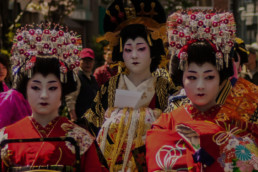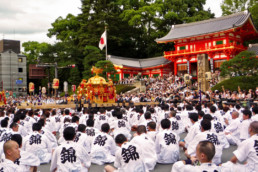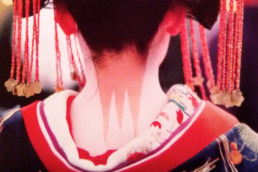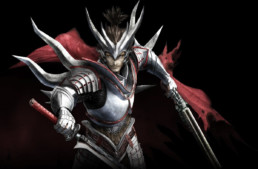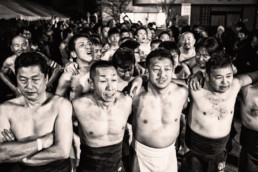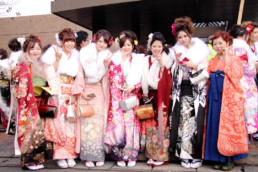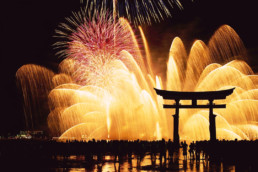Japan History: Uesugi Kenshin
Uesugi Kenshin

Photo credit: wikipedia.org
Uesugi Kenshin,( 上杉 謙信) "The Dragon of Echigo" , powerful war lord and brilliant strategist, wise administrator and man of honor. Many are the names he used in his intense life, many the battles and the enemies he fought. Among them Takeda Shingen and the famous Oda Nobunaga who is said to have rejoiced when he heard of his death. Such were Uesugi’s fame and power, and it is about him that we want to talk about this time.
Uesugi Kenshin was born as Nagao Kagetora (長尾景虎)on February 18, 1530 and died on April 19, 1578. He changed his name to Uesugi Masatora inheriting the Uesugi clan name when he became the official Kantō Kanrei (vice-shōgun of the Kantō region). To honor the 13th shogun Ashikaga Yoshiteru he changed his name again to Uesugi Terutora, finally changing it for the last time to Kenshin, the name we all know. This happened after he vowed to become a Zen-Buddhist and especially a devotee of Bishamonten, god of war.
Kenshin was referred to as "The Dragon of Echigo" because of his fearsome skills in the martial arts while his rival Takeda Shingen was called "The Tiger of Kai". In fact, in some versions of Chinese mythology, the Dragon and Tiger have always been bitter rivals who try to defeat one another, but neither is ever able to gain the upper hand.
Early life

Kenshin was the fourth son of the noted warrior Nagao Tamekage from the Nagao clan. His father was considered a great war lord thanks to his victories over Uesugi Sadanori and Uesugi Funayoshi. But Tamekage soon started a conflict with his neighboring Ikkō-ikki of Hokuriku, as the political power in the region had started to shift in favor of the Ikkō. The situation for Echigo quickly deteriorated until Kenshin’s father in 1536 gathered up an army and marched westward. However, upon arriving in Etchū, his forces were suddenly attacked by Enami Kazuyori, and Tamekage himself was slain.
Then Nagao Harukage, Tamekage's eldest son, immediately took control of the Nagao after defeating his brother Kageyasu who died in the conflict. Kagetora (Kenshin) was relocated to Rizen temple where he spent his time studying.
Until he reached 14, when he was contacted by Usami Sadamitsu and a number of other acquaintances of his late father. They urged him to go to Echigo and contest his older brother's rule. Harukage had not been able to control powerful kokujin families tearing the province apart.
Even though Kenshin was reluctant to take the field against his own brother, he was eventually convinced that it was necessary to the survival of Echigo. During one of the many clashes, in 1547, he was able to take control over the clan from Harukage. We don’t know what happened to his older brother then, we don’t know if he was ordered to commit suicide or not.
Though his rule over the Nagao and Uesugi clan were now unquestioned, much of Echigo was still independent. He immediately set out to cement his power in the region. Ogasawara Nagatoki and Murakami Yoshikiyo, two Shinano lords, both appeared before Kenshin requesting his help in halting the advance of the powerful warlord Takeda Shingen. Around the time Kenshin had become the new lord of Echigo and Shingen had won major victories in Shinano Province. With the Takeda's conquests taking them remarkably close to the borders of Echigo, Kenshin agreed to join battle.
Uesugi and Takeda

Photo credit: wikipedia.org
What followed was the beginning of a rivalry which became legendary. It started of with indecisive skirmish for a total number of five such engagements at the famous site of Kawanakajima.
In 1561, in the fourth and biggest battle they would ever fight, Kenshin used an ingenious tactic. It was a special formation where the soldiers in the front would switch with their comrades in the rear, as those in the front line became tired or wounded. This allowed the front line to always have strong and fresh soldiers. The tactic was extremely effective and Kenshin nearly won the battle a number of times. It is also said that Kenshin managed to ride up to Shingen and slashed at him with his sword. Shingen fended off the blows with his iron war fan. So Kenshin failed to finish Shingen off before he could organize a counter-attack.
The Uesugi army was forced to retreat. The result of the fourth battle of Kawanakajima is still uncertain, we still don’t know if it was Kenshin to prevail, or Shingen. But one thing is certain, both of them lost a large number of soldiers. Kenshin lost up to 3000 Samurai while Shingen lost 4000 men, also losing his younger brother, Takeda Nobushige.
Though Kenshin and Shingen were sworn rivals for more than 14 years there was often an exchange of gifts between them.The most famous one was a precious sword that Shingen gave Kenshin.
Shinge died in 1573. It is said that Kanshin cried for the loss of his great rival and vowed to never attack Takeda’s lands again. The two parties became allies in three years. In addition, there was an incident when some daimyos boycotted salt supplies to Kai province. Kenshin also heard of Shingen’s problem with the Hojo clan that had refused to send him rise. So Kenshin secretly sent to the Takeda clan some salt supplies. He also wrote to his enemy, Shingen, that according to his information some of the Hojo clan had committed a hostile action. Even if he could have cut out his supplies and so defeat Shingen, Kenshin decided not to do so because it would have been a dishonorable act. As personal reflection, Kenshin said: "I do not fight with salt, but with the sword" . His actions towards his rival set a noble example that can apply to all times. Those seeking peace often use Kenshin’s statement referring to it like :"Peace is achieved with rice and salt, not with katanas and spears".
Kenshin and Oda Nobunaga
「四十九年 一睡の夢 一期の栄華 一盃の酒」
This life of forty-nine years is passed in a dream;
Even a life-long prosperity is but one cup of sake;
Part of Kenshin’s death poem.
Starting in 1576, Kenshin began to consider the issue of Oda Nobunaga. In fact, he had since grown to be Japan's most powerful warlord of the time. With both Takeda Shingen and Hōjō Ujiyasu dead, Kenshin was no longer blocked off from this realm of expansion. So, when the death of a lord in Noto Province sparked up confusion and conflict in the area of the succession, Kenshin was quick to use the opportunity. Taking the land from the weakened clan put him in the position to threaten Nobunaga and his allies. In response, Nobunaga pulled together his own forces and those of his two best generals, Shibata Katsuie and Maeda Toshiie, to fight Kenshin, in the famous Tedorigawa battle. The expert warrior Shibata Katsuie , who had served Nobunaga from the beginning, was sent to test Kenshin’s ability on the battlefield. According to some sources, Shibata brought 18.000 to battle, and was followed by Nobunaga himself with 20.000 as backup. If this numbers were to be proven as correct, this would be the greatest battle of the Sengoku period.
Despite Nobunaga's overwhelming numbers, Kenshin managed to score a solid victory on the field. At first, Kenshin refused to engage the Nobunaga’s army until heavy rain neutralized Nobunaga’s foot soldiers. Forced to retreat, Shibata joined the main force. Then Kenshin used one of the tactics of his old rival Takeda Shingen. He pretended to send forth a small unit to attack Nobunaga's main force from behind and gave his enemy a great opportunity to crush his remaining force. Nobunaga took the bait. His force attacked at night expecting a weakened opponent at the front; instead, Kenshin's full military might was waiting. After the loss of almost a quarter of his military force Nobunaga retired toward Omi Province. Kenshin just took the chance to build some fortress in Kaga province before going back to Echigo. In October 1577, Uesugi Kenshin arranged to put forth a grand army to continue his assaults into Nobunaga's land. But we know that his health was already compromised at the time and on April 9 (according to the calendar of the Tenshō era) it deteriorated. He died four days later.
Uesugi Kenshin's death
The cause of Kenshin's death has been questioned throughout the years. The theory accepted by most Japanese scholars is that a life as a heavy drinker and probably a stomach cancer caused the end of this great war lord’s life.
However, it is also speculated that he was victim of one of the most famous ninja assassinations; a ninja had been waiting in the cesspool beneath the latrine at Kenshin's camp with a short spear or sword. (Note that the theories are not mutually exclusive — the assassin, if he existed, might simply have fatally wounded an already-dying man. )
It is said that when Nobunaga heard of Kenshin’s death he said : "Now the Empire is mine."
Kenshin’s death had dramatic consequences for his clan. While he never had children of his own, he had adopted 2 boys so that they would become his heirs. However, heard of their father’s death they started to fight each other. The conflict ended with Uesugi Kagekatsu’s victory over his brother Kagetora, becoming the new head of the clan. This internal conflict had its consequences in terms of cost and energies too. Oda Nobunaga had no problems in taking over many territories that had once been property of the Uesugi clan. The destruction of the the clan had never been so close and only Oda Nobunaga's own death once again shattered the balance of power in Japan.
Trivia

Photo credit: gacktitalia.com
Uesugi Kenshin’s historical figure and his fame have never been forgotten.
The visual kei singer GACKT played the role of Kenshin in the tv series Furin Kazan, aired from January 7, to December 16, 2007.
In August (The fourth Saturday and Sunday of the month) takes place in Jōetsu,Niigata prefecture, a festival to honor the great warrior, with the reenactment of the famous Kawanakajima battle. In the Sengoku period Jōetsu with its Kasugayama castle was the center of the Uesugi domain.
GACKT himself took part in the festival many times in the role of Kenshin, with a tremendous public success.
The writer Shino Ayako, that wrote the book "Kenshin Woman", expresses her doubts about Kenshin’s identity. There are many rumors that want Uesugi Kenshin to be a woman.
(1) He never had a wife (nor any concubine) and he never had natural children. It is said that he preferred male company to beautiful female’s company. Homosexuality might be an explanation since at the time it was a normal practice among the samurai class.
(2)Some believe that the cause of his death might have been “omushi”, which was documented to be a kind of disease related to menopause
(3)Rumors say that he would confine in the castle once a month.
(4) With reference to his armor, he had a petite stature at about 156 cm in height.
(5) He preferred wearing clothes which were in woman’s colors.
There are no proofs to support this hypothesis, but it is certain that they are still alive even today to testify that Uesugi Kenshin has left an indelible mark on Japanese History.
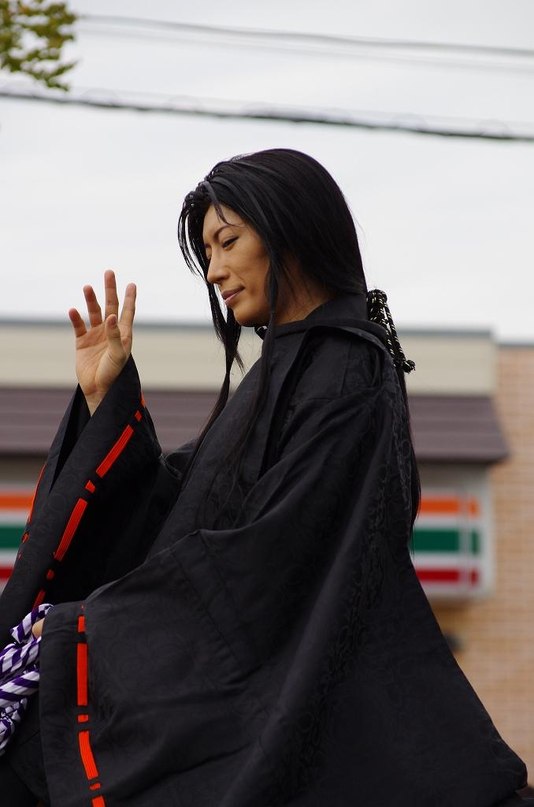
Photo credit: gacktitalia.com
Japanese Tradition: Oiran
Oiran
Courtesans that led fashion
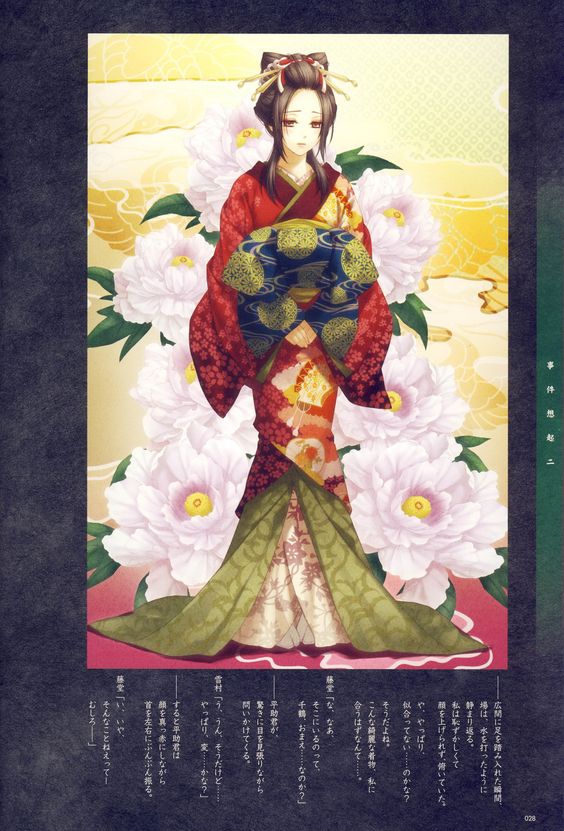
photo credit: pinterest
In ancient Japan ‘women of pleasure’ were called Yūjo (遊女). This word identified their job and also marked the difference between common prostitutes and courtesans, also called Oiran (花魁). The figure of the Oiran is the one we will analyze in this article.
The word Oiran derives from the sentence ‘oira no tokoro no nēsan’ (おいらの所の姉さん) that means ‘My older sister’. However, the literal translation would also be ‘The leader of all flowers’ since it is written with the kanji of 花 (Hana) “flower” and the kanji of 魁 (Sakikage) “leader”. At first, the word referred to high-class prostitutes of the Yoshiwara district (吉原) in Edo, today’s Tokyo. But later it was used in reference to courtesans.
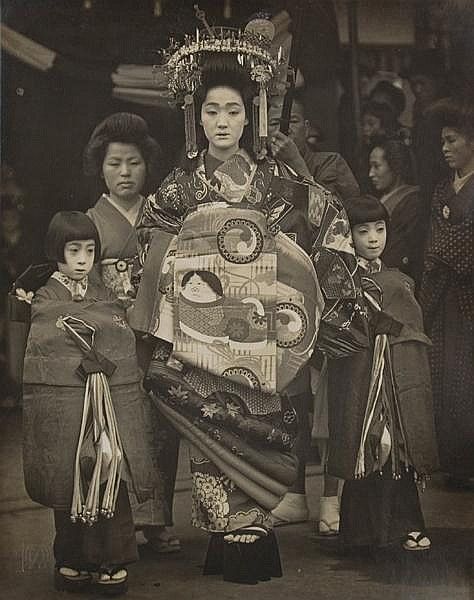
photo credit: pinterest
Oirans carried out their activities during the Edo period in pleasure districts called Yūkaku (that is not to be confused with the Hanamachi were only Geishas lived) . This districts were built outside the city center of Kyoto, Osaka and Edo, and were the only places were prostitution was legalized.
Unlike Yūjos, that sold their sexual favors, Oirans entertained their clients non only with their body but also with their abilities. These included the Sadō or the Tea ceremony, the Ikebana or the art of arranging flowers, being able to play different instruments, reading and having a good general knowledge. In fact, they had to be able to entertain the client also with their brilliant conversation skills.
The highest rank was that of the Tayū (太夫) that had the privilege to refuse a client if they wanted to. They were followed by Kōshi (格子). Their clients were part of the elite of the society like Daimyōs and rich feudal lords, and this was because the fee for a Oiran was very high. Just think that one night with an Oiran was equivalent to a whole year of a worker’s salary. To be able to meet one of them, clients had to be invited by the Oiran herself and had to enter a waiting list even weeks long.
The last official Oiran lived until 1761. The increasing popularity of Geishas made the request for Oirans decline. Nowadays this profession is not carried out anymore, if not with the meaning of preserving traditions and customs.
The most fascinating thing about Oirans is that due to the isolation they were forced into by the anti-prostitution law (prostitutes were to live in peripheral areas only) they were also idolized and mystified. They also led fashion and customs. They had the most peculiar hair-styles and the most rich and fancy kimonos with Getas (Japanese traditional shoes) fifteen cm high.
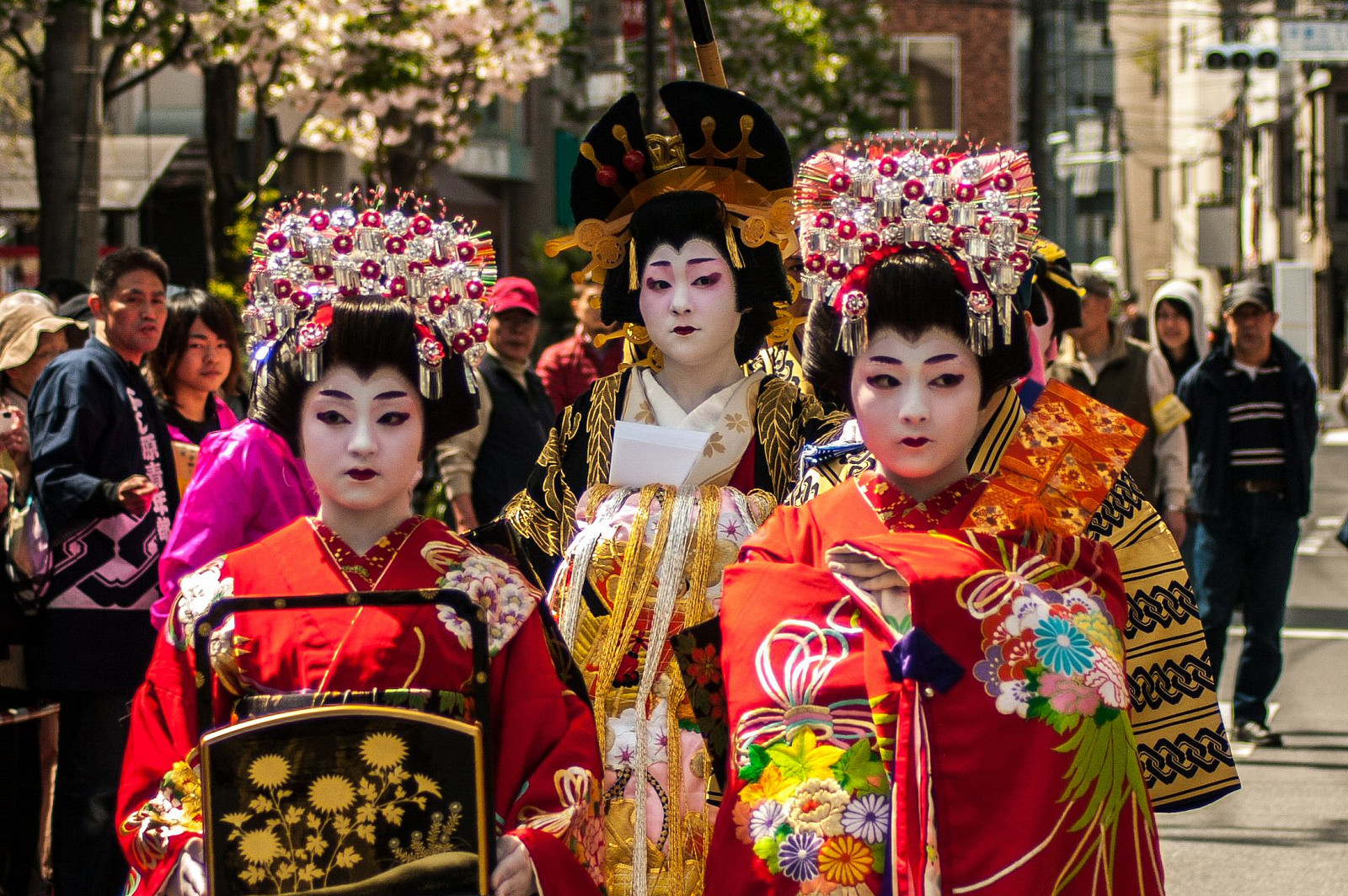
photo credit: tokyocheapo.com
Shinano, Sakura e Bunsui.
There are many events that celebrate these women during the year.
The first one, that takes place in April in the city of Tsubame, Hokuriku region, is the Bunsui Sakura Matsuri Oiran Dōchū. It is a parade famous throughout Japan were girls from different regions parade along the streets in order to obtain the role of one of the three leading Oirans : Shinano, Sakura and Bunsui. These names derive from the flowers of three different types of cherry trees. The girls parade ahead of a minimum of seventy different accompanying figures like Kamuros, their helpers, servants and concubines too. Each figure is selected every year with utmost care.
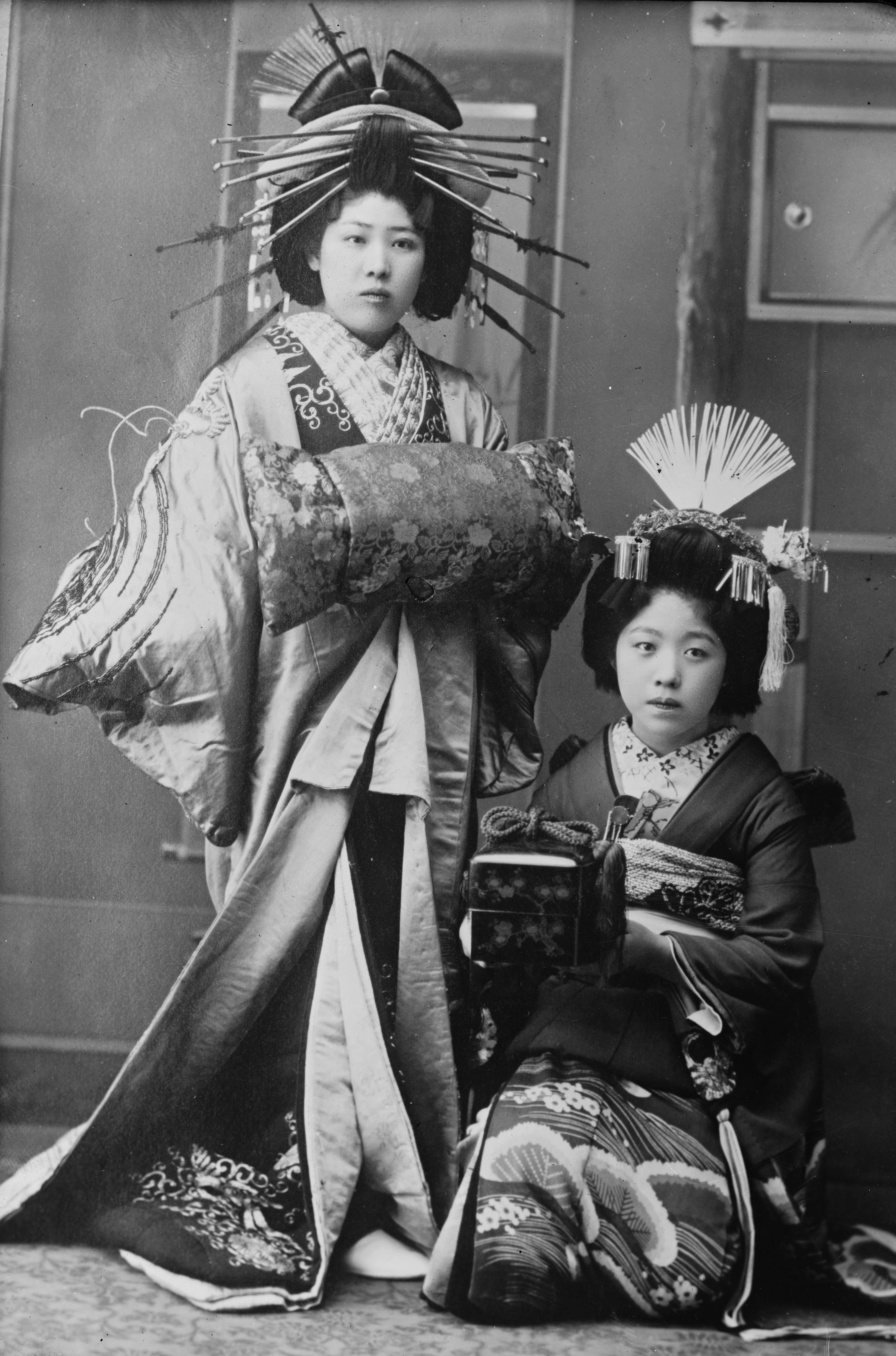
photo credit: wikipedia
In September in Shinagawa there is the Oiran Dōchū parade, and every early October in Nagoya, around the Ōsu Kannon temple, there’s the Ōsu Street Performers Festival were thousands of spectators can attend a two-days parade. Here Oirans walk down the shopping galleries of the Ōsu Kannon district with their whole entourage. Part of this entourage is the Yojimbo, similar to samurai but that actually has the role of a bodyguard, and there are apprentices too.
Charming, sensual and mysterious, like everything is in Japan, women of thousands faces and talents, beauty of an ancient time.
Japanese Tradition: Gion Matsuri
Gion Matsuri: an unique experience
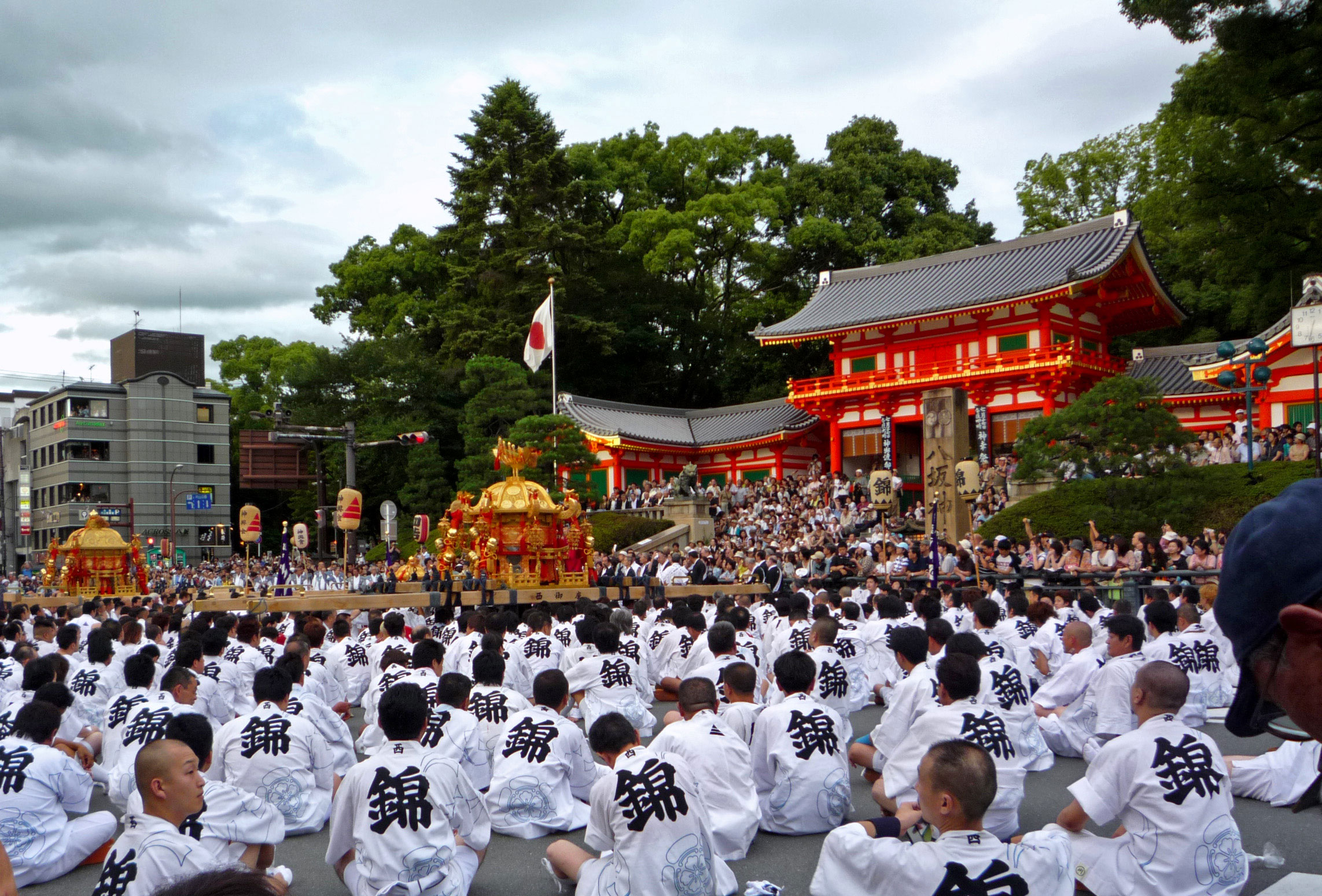
photo credit: Daranice
The Gion Festival or Gion Matsuri (祗園祭), this is how it has been called since the Meiji era, takes its name from the famous Kyōto area, Gion, Higashiyama district. It’s a religious celebration dedicated to the Susanoo God, also known as Takehaya Susanoo-no-Mikoto, worshiped in the Yasaka shrine.
Susanoo, God of the sea and storms, it’s also the God of the dead, as well as Amaterasu’s brother, from whom the Japanese Emperor’s family line is believe do descend.
Together with the Aoi Matsuri (May 15th) and the Jidai Matsuri (October 22nd), the Gion Matsuri is one of the three biggest religious festivals in Kyōto, and Japan as well. It is held every summer for the whole month of July. It is meant to calm the spirits of the dead and ask for protection over the city to the God so that he can keep illnesses and natural disasters away.
As you can imagine it’s a matsuri full of events. The most important and attractive are the Yamaboko Junkō ( 山鉾巡行, float’s parade) and the Mikoshi Togyo (神輿渡御, parade of the devine palanquins). Both this events are held between July 17th and 24th, when the festival reaches its climax.
One of the main reasons for the spectacularity of this festival is surely the size of the floats, especially the ones called Hoko. They can even be 25 meters high with a weight of over 10 tons that can move thanks to wheels about 2 meters of diameter. Every float is rebuilt every year from scratch, and then destroyed at the end of every festival. All the pieces are held together without the use of screws, as tradition wants.
But let’s move ahead with order...
A little bit of history

photo credit: kyotodeasobo.com
Tradition says that Gion Matsuri was born in 869. Since a century or so, the Imperial court had moved from Nara to Heiya-kyō (today’s Kyōto) and it was dominated by the Fujiwara family.
It is said that during a plague, the Imperial court decided to hold the first goryōe (御霊会), a purification ritual in the small Shinsen'en shrine. You need to know that at the time the city was situated in a very swampy area, very hot and humid. High concentration of people together with the absence of a proper drainage system made it easy for waste waters to contaminate clean waters. It’s not difficult to imagine that illnesses like malaria, smallpox, flu and dysentery became widely present. However, in ancient Japan the cause of all this was said to be something else entirely.
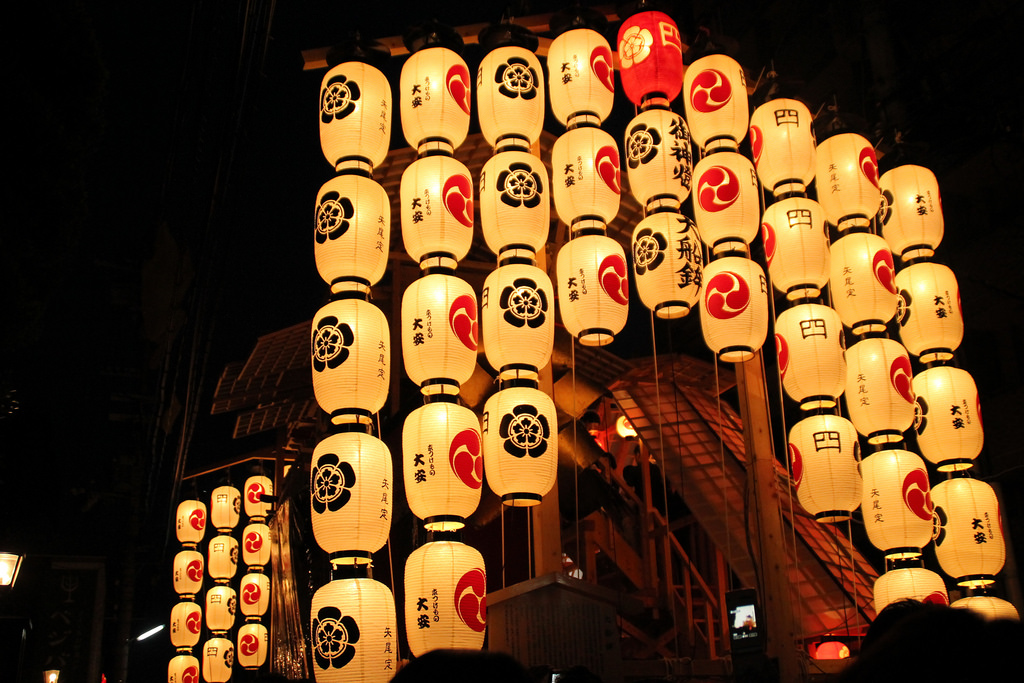
photo credit: japancheapo.com
According to the prediction of a master priest, the real cause of the plagues were devious spirits, identified in the ghosts of prince Sawara Shinnō and his companions. They, accused of the murder of the noble Fujiwara no Tanetsugu, died professing their innocence till the last moments.
The first goryōe was held while trying to calm the spirit by invoking the Susanoo God. Furthermore, the noble Urabe Hiramaru raised 66 spears, one for each Japanese region, so to enclose the evil spirits inside and purify the capital.
It was here that the custom of bringing three mikoshis, or divine palanquins, into procession was born, and it was also decided that a goryōe had to be head every time that a plague or illness was spreading.
Everything was accompanied by other celebrations and joyful moments.
Until 970, when it was decided that the Gion Goryōe (祗園御霊会) had to be held every year.
Afterward, starting from the Muromachi period, the event was enriched with the typical floats, the yamaboko (山鉾), also parading along the streets of the city. These were built thanks to the collaboration of the merchant class that in this very period lives a moment of success after centuries of denigration. Floats were adorned with decorations that became richer and more sophisticated year after year.
In other words, the parade also became a way to show off the richness of the merchant class.
In spite of some small interruptions (during the Ōnin war (1467-1477) and during World War II (1941-1945) ), the festival still lives today and can be proud of more than a thousand years of history.
Celebrations
Celebrations that,as we said, go on for the whole month of July, involve all the different areas of the city.
It kicks off on July 1st, where a ceremony called Kippuiri (吉符入) is held at the Yasaka shrine, Here, representatives of all the districts of the city in charge of the organization of the festival pray so that the it can proceed smoothly and with no incidents.
On July 2nd, at the Town Hall of Kyōto, takes place a lottery headed by the mayor of the city, through which the order of the floats for the parade is decided. Still, opening the procession is always duty of the Naginataboko (長刀鉾).

photo credit: heterophyllum
On July 10th, starts the preparation of the mikoshi (神輿), three palanquins that will house three small shrines dedicated to Susanoo. At the same time, a few buckets are immersed from the Shijō bridge into the sacred waters of Kamo river to draw the water that will be used to wash the mikoshi. In the late afternoon there’s also a parade with the exhibition of paper lanterns of traditional manufacturing that will be used to receive the God.
Also on the 10th, starts the building of the floats and walking along central streets of Kyōto you’ll be able to see theme slowly taking shape by the hands of their wise builders.
The days between the 14th and the 16th are those immediately preceding the main celebration. July 14th is known as yoi-yoi-yoi-yama (宵々々山), the 15th as yoi-yoi-yama (宵々山) while the 16th is called yoi-yama (宵山). The same goes for July the 21st,22nd e 23rd. During this days, starting from 6:00 p.m, the streets closed to traffic overflow with visitors and tourists voices. Here you can walk around vending stands, under the light of the paper lanterns always kept alive, admiring the yamabokos.
And it is also in this days that ancient families of the town open up their window so that people passing by can admire ancient treasures guarded for generations.
On July 15th, the imitaketate (斎竹建) and the yoimiya-sai (宵宮祭) are held. The first one is a ritual during which bamboo truncks are put together in square shape to delimit the area of the procession and protect it from contamination. On the other hand the yoimiya-sai is held at Yasaka shrine, and durig this ritual the spirit of the god is transferred into the 3 portable mikoshi that have already been purified.
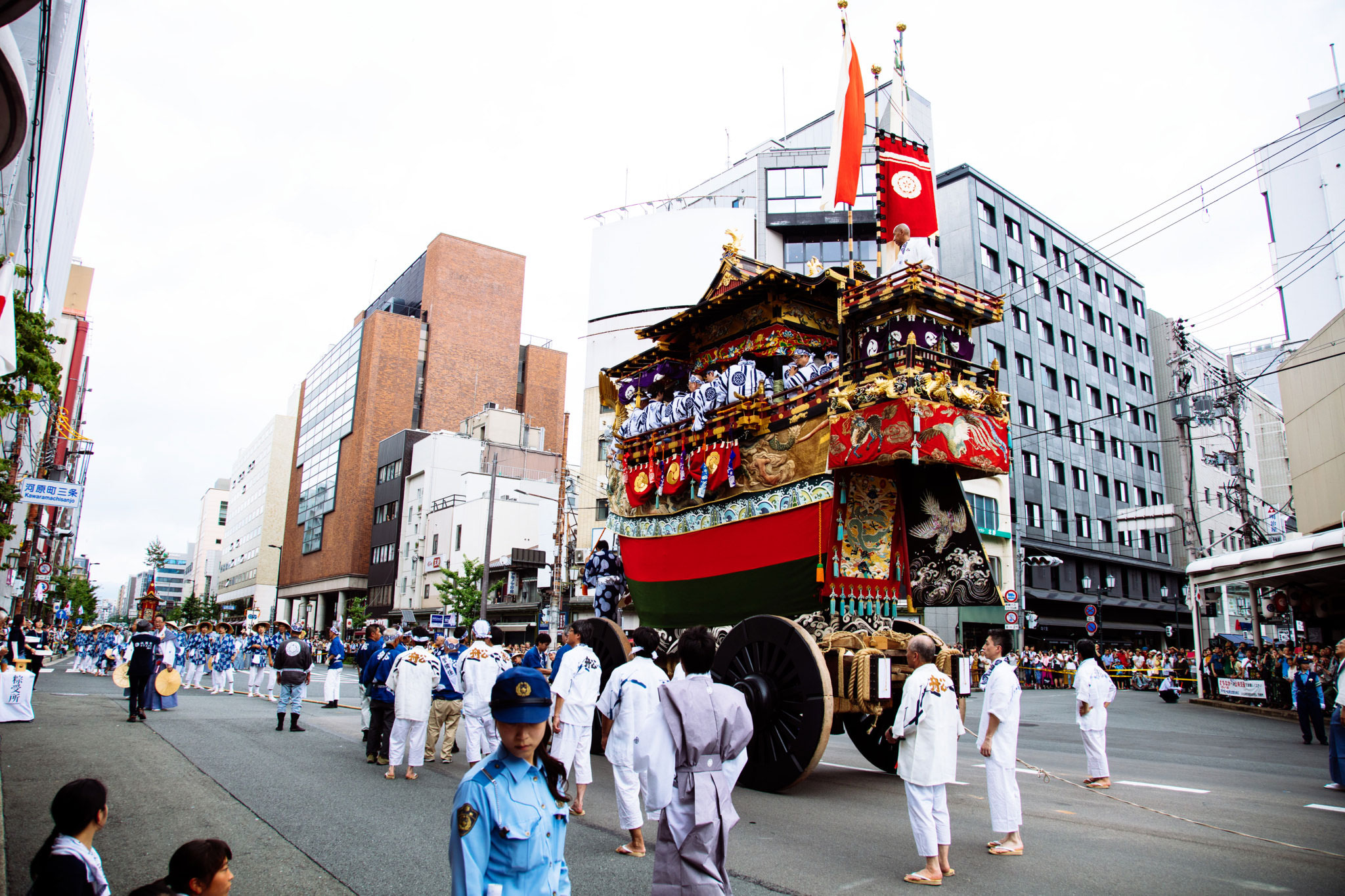
photo credit: Tomomi Onishi
In July 16th the musicians from all the floats go to the temple to pry for good weather the following day, and all is accompanied with music and dancing events along the way.
July 17th is the long awaited day in which the festival reaches its climax. It is the moment of the Yamaboko Junkō, the great floats parade. Floats are divided into 2 groups, yama 山 (mountain) and hoko 鉾 (spear). The opening group it that of the 9 hoko floats, and they symbolize the 66 spears used by Urabe Hiramaru to drive away the evil spirits. The second group is that of the 23 yama floats, smaller than the hokos, that carry life-size representations of important and famous personalities.
Every hoko carries musicians that accompanying the procession with their music.
Kon-kon chiki-chin, kon-kon chiki-chin… This is the distinctive sound of the Gion Matsuri, a traditional rhythm dating back to the Edo period.
And along the parade a profusion of many different dancers and acrobats make it even more joyful and lively. Obviously each and every one of them is dressed in colorful and rigorously traditional clothes.
Has said before the parade is lead by the Naginata-boko, called after the naginata (typical Japanese spear) that springs up from its top, and that is said to have the power to drive away evil spirits and plagues. The original Heian naginata had been forged in metal, but the one we can admire today is made of bamboo.
It is on the Naginataboko that a chigo (稚児) is carried, a young child dressed up in rich, traditional clothes with a golden phoenix-shaped headgear. This child has the duty to represent the God during the festival.
The chosen one, usually selected from the most powerful and important merchant and commercial families of the town, has to undergo a long preparation period before he is allowed to take on this role. Weeks of purification rites and complete isolation, away from everything that could contaminate him, including women. He is not even allowed to walk on common ground but he is carried by men in charge of this duty.
He will have the duty to cut with a single blow a big sacred thatch rope. This is the Shimenawa-kiri (しめ縄切り), an act through which the divinity enters the human world severing the limit that devised the two worlds, and with this act the great celebration can officially starts.
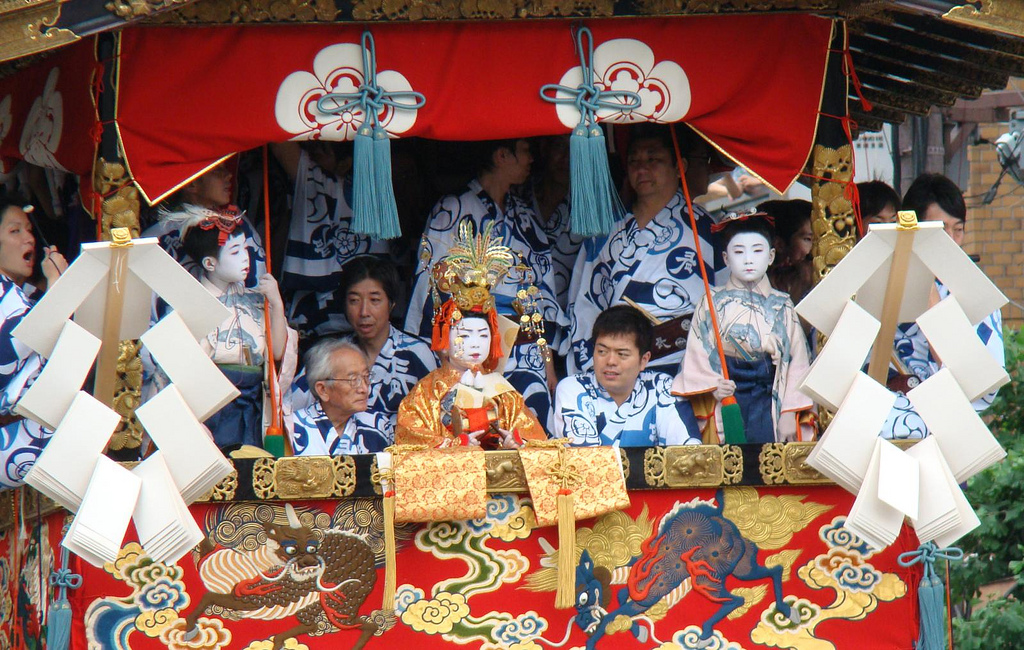
photo credit: picssr.com
In the late afternoon, takes place the mikoshi togyo, where the three mikoshis leave the temple. It is the long awaited Shinkō-sai (神幸祭), or the emerging of the divinity from the temple with its palanquins carried on shoulders around the streets of the city.
On July 24th this double procession is repeated and in the evening the three mikoshis are brought back to their temple. This is the moment of the Kankō-sai (還幸祭), through which the spirit of the God finally returns to the world he belongs to.
At the end of the parade the floats are immediately dismantled and all pieces kept until the next festival.
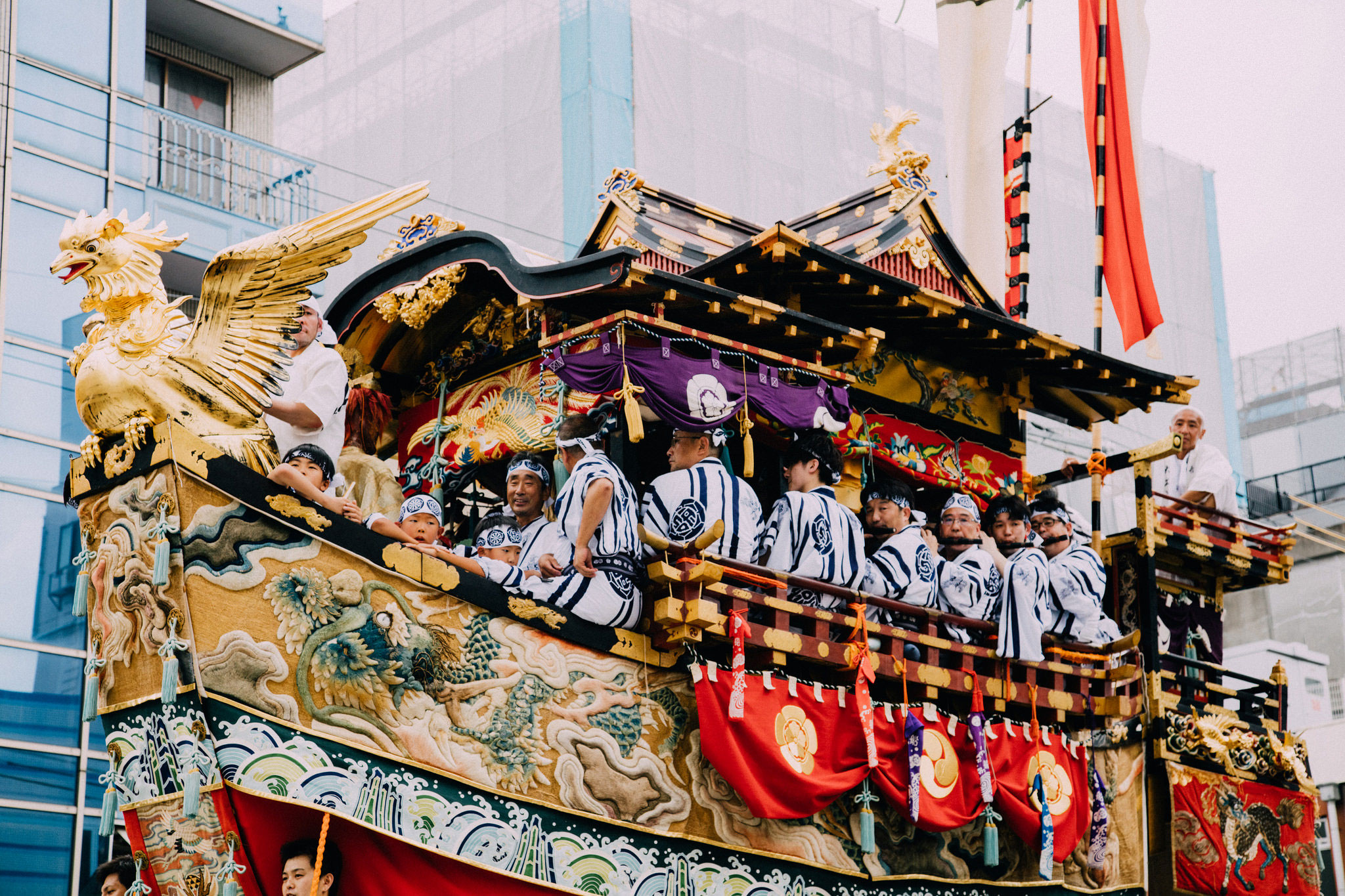
photo credit: Tomomi Onishi
On the same day takes also place the Hanagasa Junkō (花傘巡行), an event that, as suggested from the name, has flowers as its protagonist. In fact, it is written with the kanjis of hana (花) or flower, and kasa (傘) or umbrella. During the parade, the floats and all participants parading along the streets are all decorated with umbrellas and hats embellished with flowers.
The parade is opened by small mikoshis carried by young children, then follows a large parade of people in traditional clothes. There are representatives of social and cultural associations, musicians, dancers, acrobats and in particular some of the most famous geishas and maikos of the town. And they surely are the loveliest flowers displayed the event.
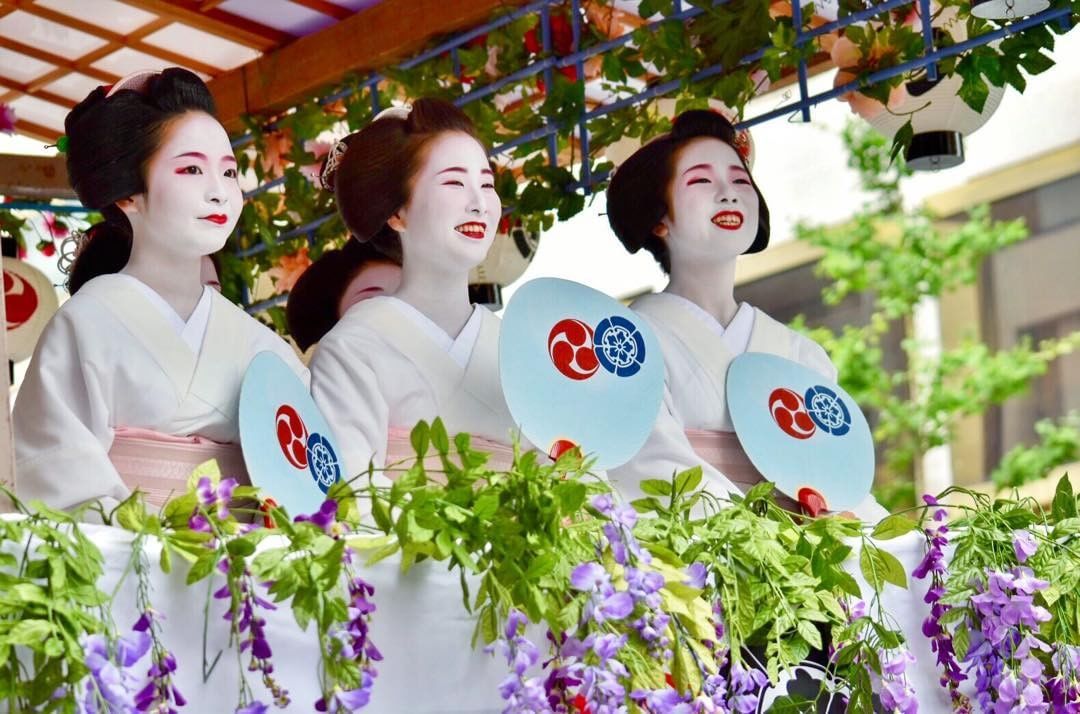
photo credit: geimei.tumblr.com
On July the 28, takes place the ceremony of the mikoshi-arai (神輿洗式),or the ritual of washing the mikoshis at Yasaka shrine, to purify the three palanquins, till next year.
If you are around don’t miss this moments. In fact, it is said that being hit by little splash of the water dedicated to the god brings good luck..
To mark the end of the Gion Matsuri there is the nagoshisai (夏越祭) festival, that is held every July 31st at Ekijin shrine.
Tied to the tori, the entrance gate that marks the beginning of the sacred area of the temple, there is a big thatch rope in the shape of a circle with 2 meters in diameter. It is the Chinowa (茅の輪).
Please do pass through it to be purified, and then you’ll receive a protection charm on with there’s written “Somin-shorai shison nari(蘇民将来子孫也) that means “I’m Somin Shorai’s descendant”. According to the legend, Somin Shorai was a simple man that one day happened to give hospitality to a traveler that had already been refused by a rich man. The traveler then reveals himself as a God and to thank him for his hospitality teaches him how to make lucky charms. Since then it is believed that this charms can push away catastrophe and thieves.
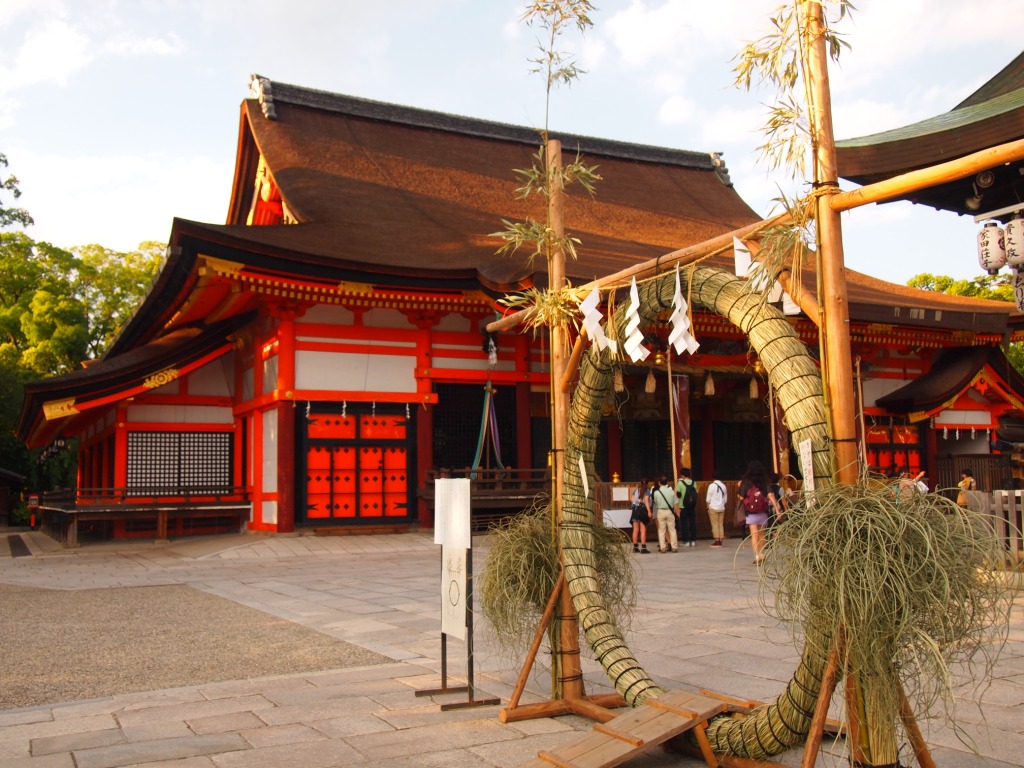
photo credit: kyoto-tabiya.com
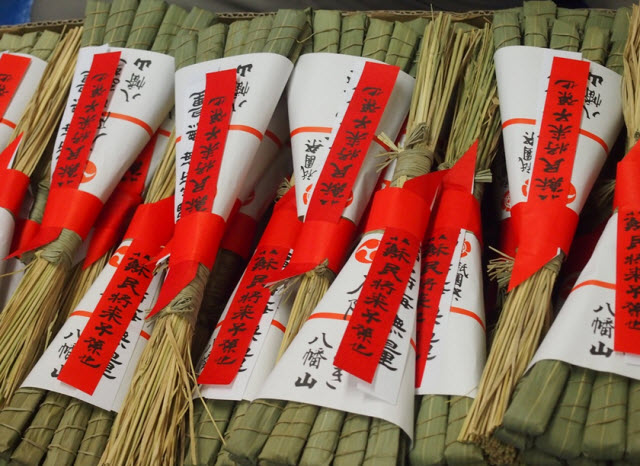
photo credit: kyotoiju.com
That of the Gion Matsuri in a long trip in which History and legend, religion and entertainment are entwined together. It is real a one-of-a-kind event.
And you? Have you ever been able to take part to it? We are waiting for your comments and experiences!
Japanese Culture: Geisha & Maiko
Maiko and Geisha: Dancing Artists
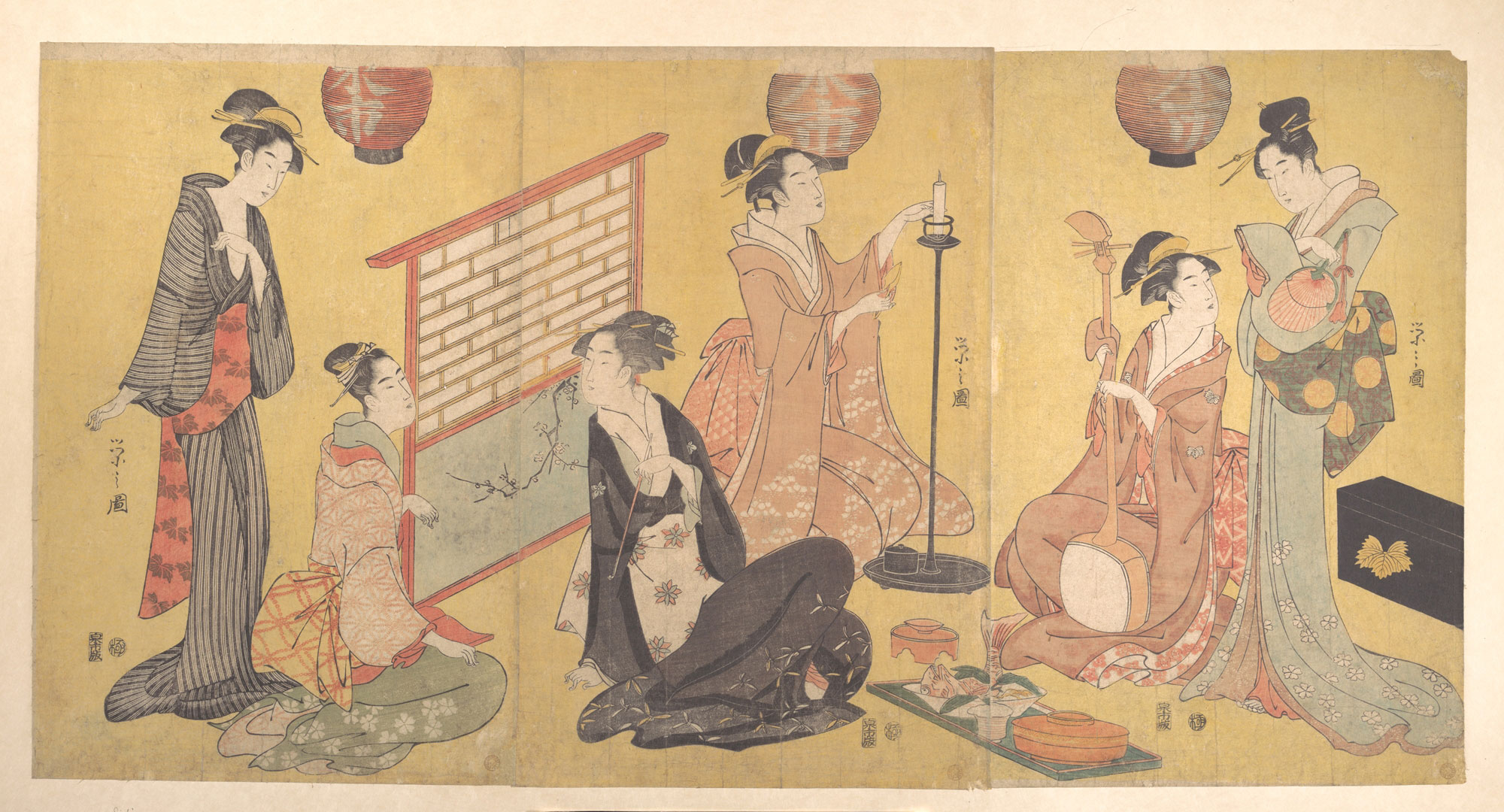
photo credit: metmuseum.org
The most representative and mysterious artistic figure of the 'Country of the rising sun' is the Geisha (芸者 "Person who embodies art").
She is often confused with the Maiko (舞妓 "Dancing girl") that is the apprentice and aspiring geisha. To become a geisha is required a long period of apprenticeship in dedicated schools. Here girls learn how to dance, sing and the use of the Shamisen (三味線 "Three strings" typical musical instrument). Regarding the skills of entertaining costumers, the maiko learns everything following a geisha around the many tea houses. The relationship between maiko and geisha is like a real ‘Sisterhood’. The two of them respectively call each other imoto-san or “younger sister”, and onee-san “big sister". The bound between them is so strong that the stage name of the future geisha is chosen by her big sister, and the maiko will carry that name for all her artistic career.

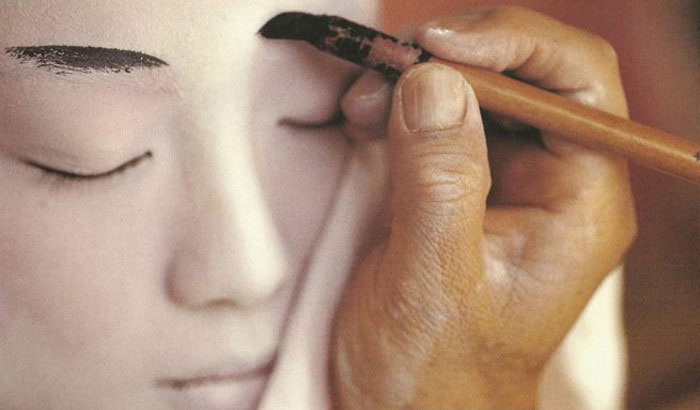
photo credit: freshdesignpedia.com
The bright colors of their kimonos will become darker as the geisha becomes older. The Nihongami, the typical hair-style of the Edo period, is very intricate and difficult both to realize and to maintain. It is usually embellished with the Kanzashi, decorative hair ornaments that would vary depending on the season (for example flowers in spring, doves for the New Year). The kanzashi too will become simpler over time, and the excessive make-up, with its typical small carmine lips standing out on a snow-white face, will be substituted with a different one for a more natural effect.
The little habit of exposing the neck (in the Japanese culture the neck is the most sensual part of a woman) will add another painted white line to the two lines previously used.
In the past the daughters of geishas would start on this path at a young age. Nowadays it is more common to start the apprenticeship after completing university studies. Nevertheless, this is a career started out of their free will and not in order to continue a family tradition. It must be said that this community made of women, with their strict traditions and strong moral ethics, is determined to keep its centuries-old secret.
“The art of being a woman”

photo credit: Pinterest
Usually, in the common imagery, geishas are women full of charm but submissive, devoted to their man and their every little whim. However this is a mistake since in the past they were the first women in the Japanese society with full autonomy.
Everything started from the Taikomochis (太鼓持), jesters that entertained the Shōgun (将軍 "commander of the army") and his Daimyō (大名) the nobility, with acrobatic exercises and jokes.
In spite of the Taikomochis being really appreciated for their carefree spirit, this figure came to slowly disappear with the appearance of the first geishas. Obviously the created a sensation and they were soon preferred to taikomochis for their sensual movements and feminine gracefulness.
But these women were not courtesans nor prostitutes. Prostitutes were identified as Oirans (花魁). Geishas were artists highly requested. Theirs skills included dancing, singing and music in general. They also had to be good conversationalist and entertainer. They would perform their profession in the Okiya (置屋) or “Geisha houses” in Kyoto, the capital of the Empire at that time. During the second half of ‘800 the isolation of Japan, that had lasted for about two-hundred years, came to an end. This was the exact moment when Europe came in contact with a new exotic harbor.
With this, the whole world came to know the figure of the geisha and her charm. And they would influence the occidental style and costumes too. Puccini composed the moving Madame Butterfly, and in the field of the pictorial arts they became muses for well-know painter of the time. Manet, Monet, Klimt, Renoir and Van Gogh are just some of the artists that tried to take their inspiration from this so-called Nipponism. This artistic movement was a tribute to the art of the Ukiyo-e (浮世絵 "picture of the floating world). And not only this, we find geishas in the prints of Katsushika Hokusa (The Great Wave off Kanagawa) and Kitagawa Utamaro. Utamaro in particular became famous for his prints dedicated to women. The more this artistic movement grew in Japan, the more the ukiyo-e prints became famous all over the world too, and the demand for it equally increased.
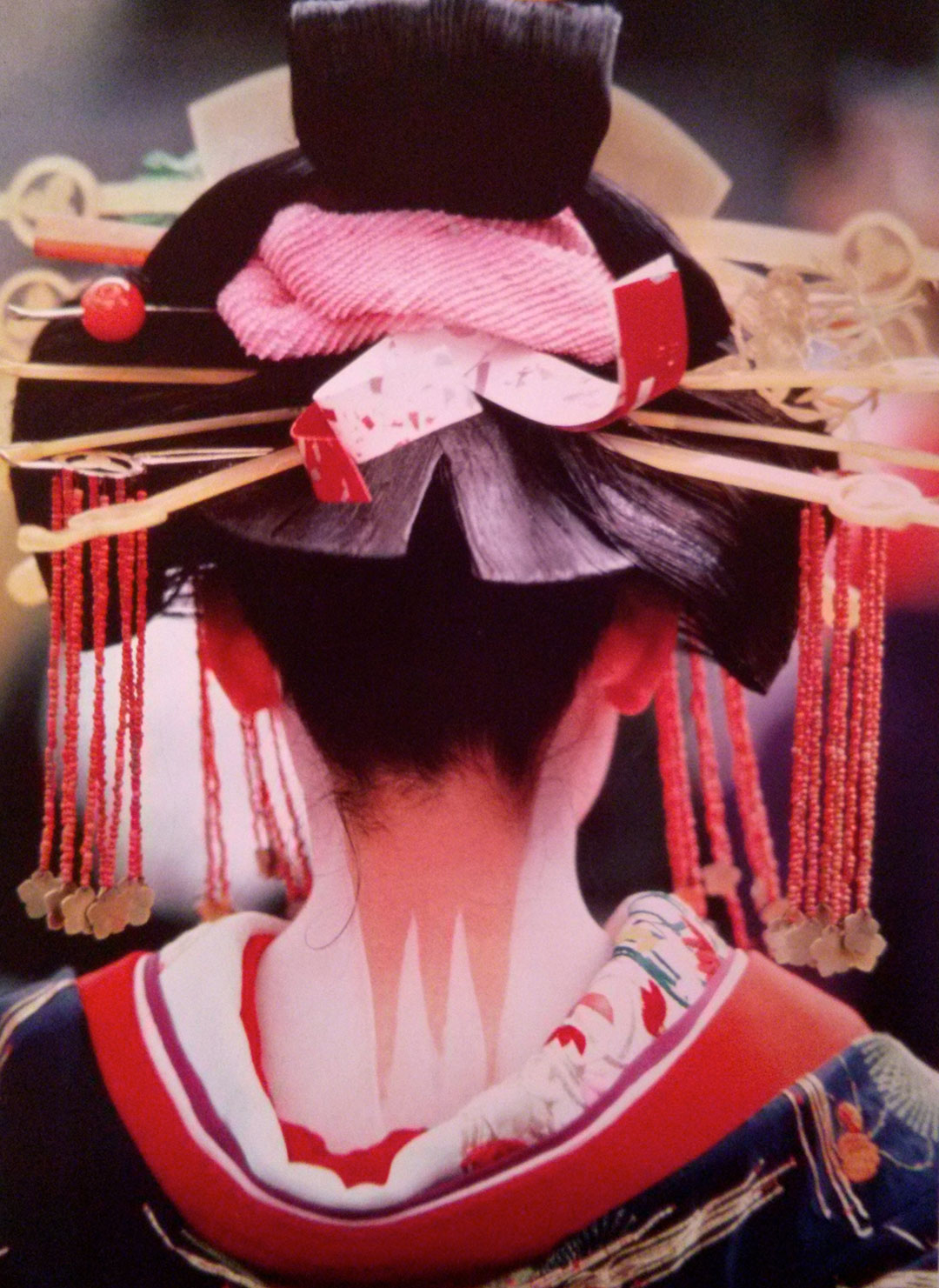
photo credit: makeuppix.com
“Wives of nightfall”
During the Second World War with the arrival of American soldiers the figure of the geisha was distorted. They were given the role of prostitutes because the young girls comforting the soldiers were called “geisha girls”. This produced an anti-feminist and erroneous idea of this women.
It was really difficult for the geishas to focus on love because of the strict rules required in this profession. They could have as sole companion their Danna (旦那). In Japanese “danna” means master and he was the closest thing to a husband for them. He would take care of his protege financially supporting her performances, and sometimes extinguishing the debt that she had with the okiya for her instruction. Usually it was the danna that would chose his geisha, not the contrary. Nevertheless it was not rare for them to fall in love.
Luckily times have changed. Today geishas can freely fall in love with the person they want, but obviously they will put an end to their activities after marriage. It is common for ex geishas to become dance teachers.
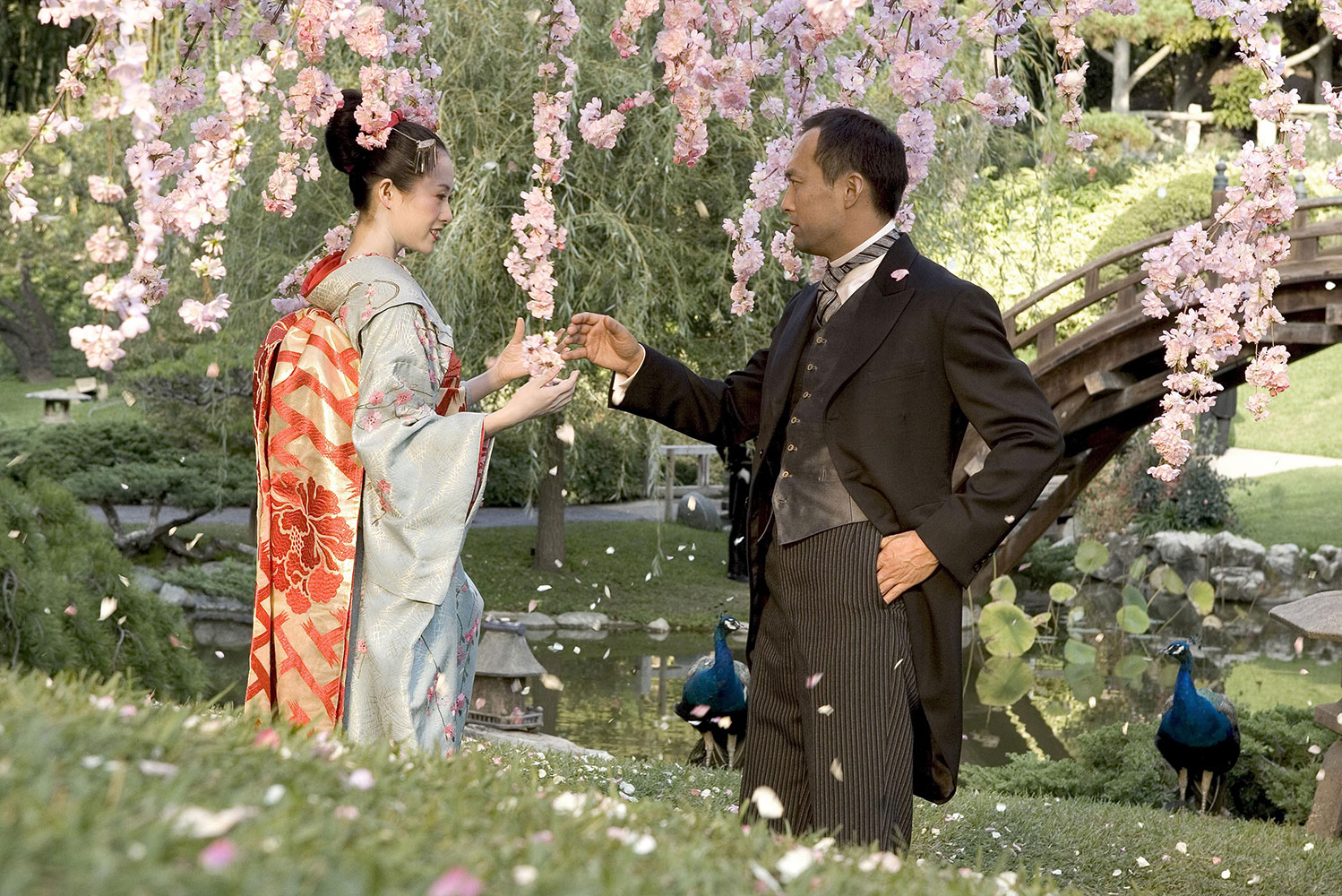
still from the movie "Memoirs of a Geisha"
The number of geishas is strongly decreasing and it is a profession kept alive mostly for touristic purpose. In fact, their audience is not made by men only, but women appreciate them too.
I would like here to report the marvelous words of Arthur Golden that with his best seller “Memories of a Geisha” created a beautiful picture of this figure. He allowed us to rediscover this parallel universe half-way between the past and the modernity.
“Geisha is an artist of the floating world. She dances. She sings. She entertains you. Whatever you want. The rest is shadows. The rest is secret.”
Japan History: Oda Nobunaga
Oda Nobunaga

A copy of Oda Nobunaga's portrait by the Italia painter Giovanni Nicolao, probably commissioned by Nobunaga himself.
Oda Nobunaga is the son of Oda Nobuhide one of the daymio from the Owari province. When his father died in 1551, he started to go completely crazy taking the distance from the Oda clan allies, preferring his brother Nobuyuki.
Even if he was Nobuhide's heir, he wasn't sure to be able to succede him. The Oda clan was subject to Kanrei Shiba Yoshimune, head of this clan was Nobunaga's uncle, Nobutomo. Even Nobutomo had Yoshimune killed when he tried to help Nobunaga. Despite that, he managed to get help from another uncle, Nobumitsu up till he conquered the castle of Kiyosu. Here Nobutomo was killed and Nobunaga lived here for the next 10 years.
Oda Nobunaga also, thanks to the alliance with the Imagawa clan and the Kira clan, was able to move his army in the Mino province (1555). All this to help Saitō Dōsan. However, ths campaign proved to be a failure because Dōsan was defeated in 1556 and Yoshihatsu took his place.
A few months later, Nobuyuki, Shibata and Hayashi Katsuie Hidesada, challenged Nobunaga to control the Oda clan, but lost. However, they were forgiven thanks to Nobunaga's mother who interceded on their behalf. Nevertheless, Nobunaga continued to be suspicious of Nobuyuki, much to pretend to be sick to invite him to his castle in Kyiosu and assassinate him in 1557.
From 1559
In 1559 Nobunaga had defeated all kinds of internal opposition to the clan becoming Lord of Owari.
For a while he has continued to enter into alliances with other damiyō thanks to Kanrei Shiba Yoshikane. However when he found them to be in talks with Kira and Imagawa in an attempt to attack the Oda clan, he went to war.
In 1560 Nobunaga faced the great army of Imagawa Yoshimoto. This army was formed by a number of men who oscillated between 20,000 and 40,000 men. Although he was marching towards Kyoto, with his small army of 2000 men, he played it smart. In the famous battle of Okehazawa, he took advantage of a violent and sudden storm to attack the camp of Imagawa and kill Yoshimoto, surprising the whole country for the lightning victory. Since that time, the name of Oda Nobunaga was famous throughout Japan and the Matsudaira clan signed an alliance with him.
Saitō Yoshitatsu of the Mino province, died in 1561 and was succeeded by his son Tatsuoki. However, he was too young and inexperienced to win the confidence of his vassals. Nobunaga obviously took advantage of the situation and moved his castle in Komaki to attack Mino. Then he convinced the vassals to leave their incompetent and inexperienced Lord. In 1567, Oda Nobunaga was able to take possession of the castle and to exile Inabayama Tatsuoki. Nobunaga moved into his new castle, renaming it Gifu. The word Gifu came from Mount Gi, from which the conquest of China set off by the Zhou Dynasty and Tenka Fubu. With this he also forged a seal, which means "one military sign under the sky", this was a way of saying that he would like all of Japan under one sword and fill Japan with military glory.
From 1564
In 1564, Nobunaga gave his sister Oichi in marriage to Azai Nagasama, securing the support of the Azai clan. In 1568, Ashikaga Yoshiaki, brother of Yoshiteru, went to Gifu to ask for Nobunaga's military aid to oust the shogun Yoshihide. Nobunaga agreed to get one shogun to legitimize their military campaigns and at the same time being in control of the capital Kyoto. Nobunaga conquered all the castles of Rokkaku. Yoshiaki became shogun and offered Kanrei's place to Nobunaga, but he refused.
As soon as Yoshiaki realized he was manipulated by Nobunaga, he began to plot against him seeking allies willing to fight. Thanks to the alliance with the Asakura clan, Yoshiaki entered a conflict with the Oda clan and even managed to afflict them heavy losses. In the battle of Anegawa, Nobunaga defeated the armies of the Azai and Asakura clans.
From 1571
In 1571 he attacked the Buddhist monastery of the Tendai Enryaku-ji school. At this point he attacked the Nagashima fortress, killing thousands of people.
Despite being in a good relationship with the Oda clan, the Takeda Shingen Takeda clan joined the alliance against Nobunaga. In 1572 he marched to the capital, but died in 1573 before reaching it so Nobunaga defeated Yoshiaki and exiled him ending the Ashikaga shogunate.
In the same year the Azai and Asakura clans were finally defeated, and his brother-Azai Nagamasa, after giving back his sister Oichi, performed seppuku. The heir of Shingen Takeda Katsuyori, was defeated in 1575 in the Battle of Nagashino. Here the Oda-Tokugawa faction used for the first time the muskets purchased from the Portuguese. The army of Takeda was mowed before reaching the melee clash.
Azuchi Castle
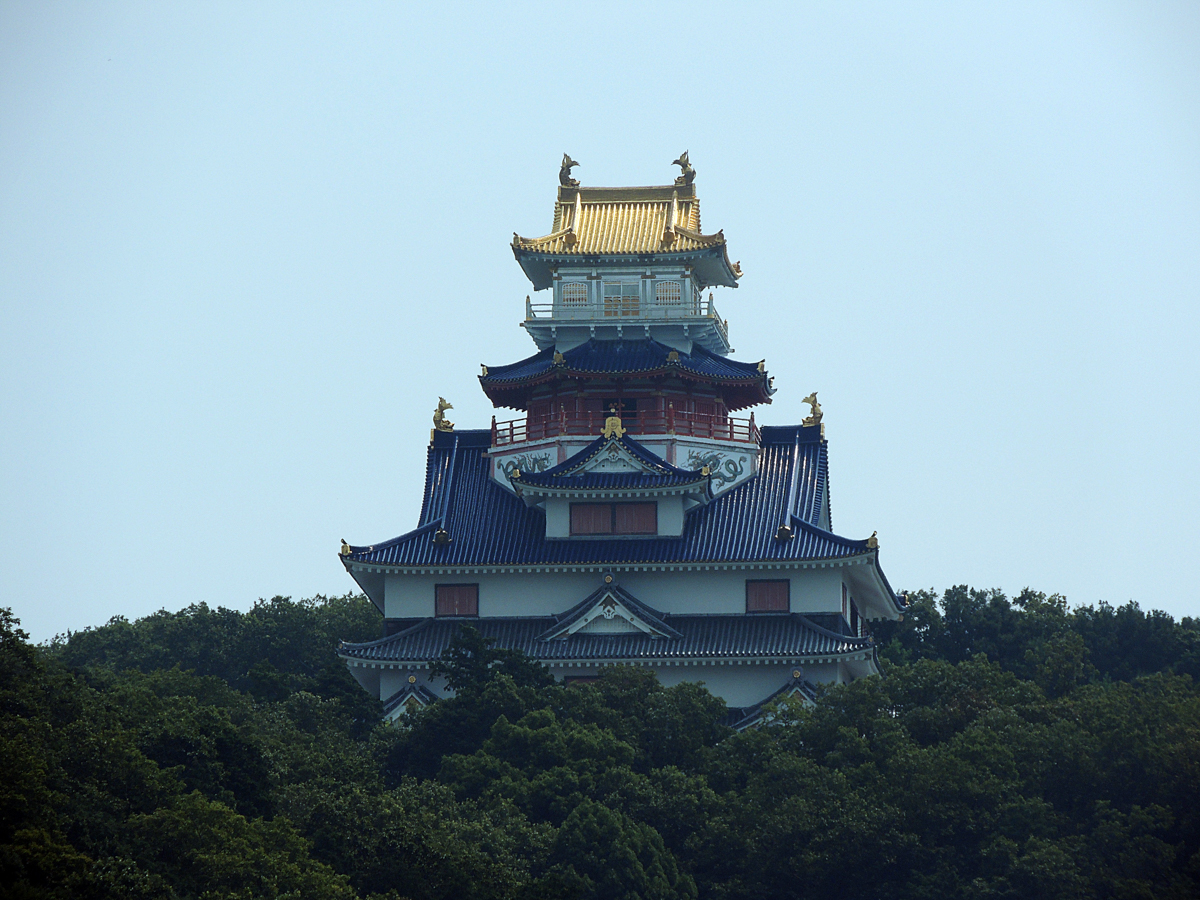
Continuing his expansion, Oda Nobunaga began to dislocate his generals in control of individual provinces. Shibata Katsuie and Maeda Toshiie were sent to the north and Akechi Mitsuhide to the Tamba province. Hashiba Hideyoshi was instead sent to the West in 1577 against the Mori clan. The latter was sustaining with supplies by sea the Ikko fortress of Ishiyama Honganji. Here Nobunaga's army ran the siege for some time from the ground.
In 1578, the new Nobunaga's castle was completed, known as the castle of Azuchi. Impressive for its extravagant decorations, the period between the fall of the Ashikaga shogunate and the death of Nobunaga was named from this castle. This is now known as Azuchi period.
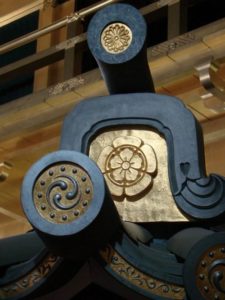
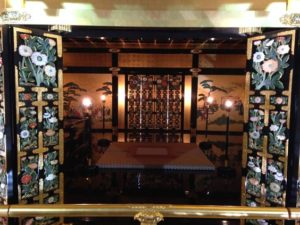
Oda Nobunaga & Uesugi Kenshin
In 1577, however, Uesugi Kenshin, the second best general of his time after Takeda Shingen, decided to take part in a second anti-Nobunaga alliance. The first encounter took place at the Battle of Tedorigawa, resulting in a decisive victory for Kenshin. Uesugi then began to prepare his march on Kyoto. According to one tradition, Nobunaga allegedly confessed to one of his officers that if Kenshin had come to Kyoto with his army, he would have no choice but to surrender and hope to be spared. Uesugi Kenshin, however, died, possibly of a heart attack, or perhaps stomach cancer, while he was in his wash house. According to sources of the time, his health seemed compromised since some time.
Without no good rivals, Nobunaga forced the last Ikko rebels to surrender in the fortress of Ishiyama Honganji in 1580. This completely destroyed the Takeda clan in 1582, during the Battle of Temmokuzan.
Nobunaga was now the undisputed authority in the country, and was preparing to move his armies against the provinces of Echigo, and Shikoku.
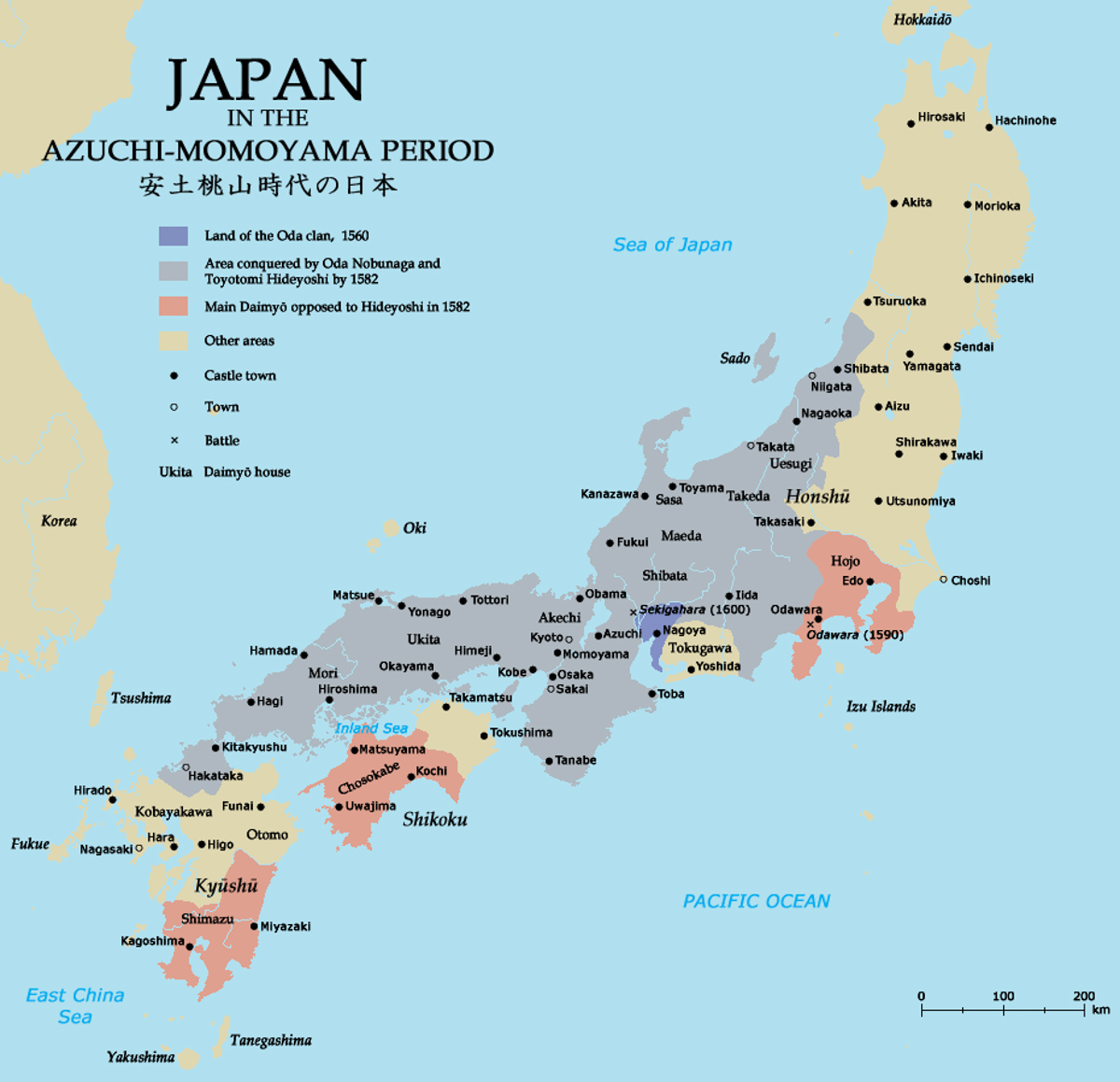
Japan in 1582. The purple areas indicate the territories controlled by Oda Nobunaga in 1560, and the gray areas indicate the territories controlled by Oda Nobunaga until his death, in 1582.
From 1582
In 1582, Hashiba Hideyoshi, one of the generals closest to Nobunaga, invaded the province of Bitchu, besieging the castle Takamatsu. The latter was vital to the Mori clan, because it occupied a strategic position from which it was easy to penetrate into their domain. Mori Terumoto arrived with his army in support of Takamatsu Castle. The two sides found themselves in a stalemate. At this point, Hideyoshi asked reinforcements to Nobunaga.
It was noted that Hideyoshi didn't really need reinforcements. However, he still asked the help of his Lord. According to some, he did it not to directly take credit for the victory, because many generals do not take kindly to the success of a general of humble origin and not part of a samurai clan. According to others, Hideyoshi intended to put Nobunaga in a critical position so to be able to take a personal advantage.
In any case, Nobunaga left the preparations for the invasion of Shikoku to Niwa Nagahide and went with Akechi Mitsuhide to reach Hideyoshi. Along the way, Nobunaga and his men paused in Honnō-ji temple in Kyoto. Here Nobunaga, being at the center of his rule and considering himself safe, was guarded only from a few trusted servants and guards. Unexpectedly, Mitsuhide Akechi ordered his men around the temple in an attempted coup. In the skirmish that followed, Nobunaga lost and retreated inside the temple and Mitsuhide, applying the technique that Nobunaga had so often used, set fire to the temple.
Oda Nobunaga and the legend of his death
It is not known what happened to Nobunaga in his last hours of life. Probably he and his attendant Mori Ranmaru accomplished seppuku while the temple was burning. His remains were never found in the rubble of the temple, giving rise to a wide range of popular legends.
Immediately after the coup, Mitsuhide's men attacked the Nijo Castle, where they forced Nobunaga's heir, Nobutada, to perform seppuku in return.
For eleven days Mitsuhide met various members of the Oda clan and the imperial court to be appointed successor of Nobunaga invain. Upon receiving the news, Hideyoshi signed a truce with the Mori clan. Then he reached out and killed Mitsuhide at the Battle of Yamazaki after only 11 days from Nobunaga's death
Oda Nobunaga, the head of the clan
Nobunaga never accepted any of the titles that were offered. He remained only the head of the clan Oda and the daimyo of Owari. Nevertheless, his authority allowed him to introduce major changes in the country.
One of the most important news of the Azuchi-Momoyama period was the creation of samurai families. In the Muromachi period in fact the many wars had led the clans to accept in their armies anyone skilled in combat. During the Sengoku era basically every male Japanese adult belonged to at least one military organisation.
From 1576 Nobunaga began to confiscate weapons to peasants in the territories he controlled. In this way he reduced the risk of riots and the number of fighters from him not directly controllable. His successor Toyotomi Hideyoshi, despite being originally from a family of farmers, completed the work. He recognized by law the samurai caste. Access to this caste could thus take place only by inheritance by banning all non-samurai to carry firearms. Samurai families who had opposed Nobunaga first, and then Hideyoshi and Ieyasu, were declared illegitimate. Their components became rōnin or civilians.
Oda Nobunaga's military plan
On the military level, Nobunaga led his army to the technological level of the European ones. He took the first large-scale spears, firearms, armored ships, and fortifications worth of the period of mass wars. Some sources also attribute to him the creation of the multi-line formation of the troops equipped with muskets. In this way he was able to ensure continuous focus and therefore a greater impact on the enemy. This tactic, used for the first time in 1575 during the Battle of Nagashino, would in fact appeared in Europe only in 1590. Nobunaga made the first extensive use of European weapons for its military campaign. He brought a radical change to the antiquated military tactics employed by Japanese armies.
His wars, however, are remembered primarily for their violence and ruthlessness. To this we can add the practice of burning enemies alive, that Nobunaga used as a warning to his opponents.
Oda Nobunaga focused on the specialization and professionalization of his army. He gave assignments and promotions based strictly on merit, almost completely ignoring the rules of nobility and family relationships. The rise of Hideyoshi is a prime example of this.
The defeated daimyō expropriated lands then redistributed them among his vassals not based on size, but on the production of rice. With some modifications, Oda Nobunaga's organizational system was extended to the entire country with the beginning of the Tokugawa shogunate.
Oda Nobunaga's economic plan
Economically, Oda Nobunaga showed great competence, building castles as focal pin for the economy. In this way he favored the migration from an agricultural economy to a manufacturing type. He built roads between the castles, to facilitate commercial traffic and the movement of armies. He conformed the units. He enhanced the international traffic, with China and Korea also with Nanban ("southern barbarians", a term that covers the Philippines, Siam, and Indonesia, but also Europe). Moreover, he established the Rakuichi Rakuza, to encourage the opening of unions, associations and guilds, prohibiting monopolies that Nobunaga considered an impediment to trade and he also developed laws requiring cases of tax exemption and regulated the contraction of debts.
Oda Nobunaga and the art
Thanks to the wealth accumulated over time, Oda Nobunaga financed various forms of art, and built beautiful gardens and castles. His castle of Azuchi on the shores of Lake Biwa is described by contemporaries as one of the best in history. Covered with gold and statues on the outside and decorated inside with screens, sliding doors, paintings on the walls and ceilings, especially by Kano Eitoku. In this period, Oda Nobunaga's master of ceremonies, Sen no Rikyu codified the rules of cha no yu, the tea ceremony. Nobunaga made this ceremony very popular and used it to discuss politics and business. Under his rule the first examples of kabuki also appeared, developing more organically in the more peaceful Edo period.
Oda Nobunaga and European Culture
Nobunaga was very interested in European culture, so much so that he collected works of art, arms and armor from the west of the world. It is considered one of the first Japanese to be wearing European clothes. Although not religious, he supported the Jesuit missionaries in Japan as a political move against Buddhist monks. Under his rule, on August 15 1576, it was built the first Christian church in Japan.
According to the sources Oda Nobunaga and the entire Oda clan were descendants of both Fujiwara and Taira clans. His ancestry can be directly traced back to his great-great-grandfather Oda Hisanaga, followed by Oda Toshisada, Nobusada Oda, Oda Nobuhide, and Nobunaga himself.
Oda Nobunaga today
Nobunaga appears frequently in the narrative and continues to be described in many anime, manga, video games and movies. It is generally described as evil nature or even demonic, although some of the works depict him in a more positive light. This type of work includes the films of Akira Kurosawa Kagemusha - The Shadow Warrior. Here the character of Nobunaga is energetic, athletic and respectful of his enemies. In Goemon he is described as a master of Ishikawa Goemon. Nobunaga is also a protagonist of the historical story Taiko Ki Eiji Yoshikawa, here is a firm but benevolent lord. It is described in a heroic manner even in some video games as Kessen III, Ninja Gaiden 2 and the Warriors Orochi series. In one of the Hunter × Hunter Ghost Brigade members is a samurai named Nobunaga Hazama.
Oda Nobunaga nelle serie TV e videogiochi
In contrast in the series of novels and anime Yōtōden, he is described literally as a demon and a lord of warhungry for conquest. In the novel The Samurai's Tale by Erik Christian Haugaard, he is an antagonist "known for his merciless cruelty." It is described as evil or megalomaniac in some manga and anime series including Samurai Deeper Kyo and Flame of Recca.
Nobunaga is described as evil, bloodthirsty, and / or demonic in many video games such as Ninja Master's, Sengoku, Inindo: Way of the Ninja and Atlantica Online, and the game series of Onimusha, Samurai Warriors, Sengoku Basara (and its adaptation as anime) and Soulcalibur. It is also mentioned in Detective Conan in an Osaka case (283-285 episode of the anime).
There are also numerous examples of his descriptions in a more neutral or historical context. These are found especially in the taiga drama (fictional series) on Japanese television. Oda Nobunaga also appears in the manga series Tail of the Moon, Kacchu no Senshi Gamu and in the historical novel by Tsuji Kunio The Lord Shogun of the Warring States. Historical representations in video games (mostly in Western strategic games) include Shogun: Total War, Total War: Shogun 2, Throne of Darkness, "dominations", Ninja Commando and the series Nobunaga's Ambition, like Civilization V and Age of Empires II: The Conquerors and Sengoku Basara.

Oda Nobunaga was also played by the Japanese singer and actor GACKT in live action Sengoku Basara -Moonlight Party- taken from the video game Sengoku Basara, which aired in 2012.
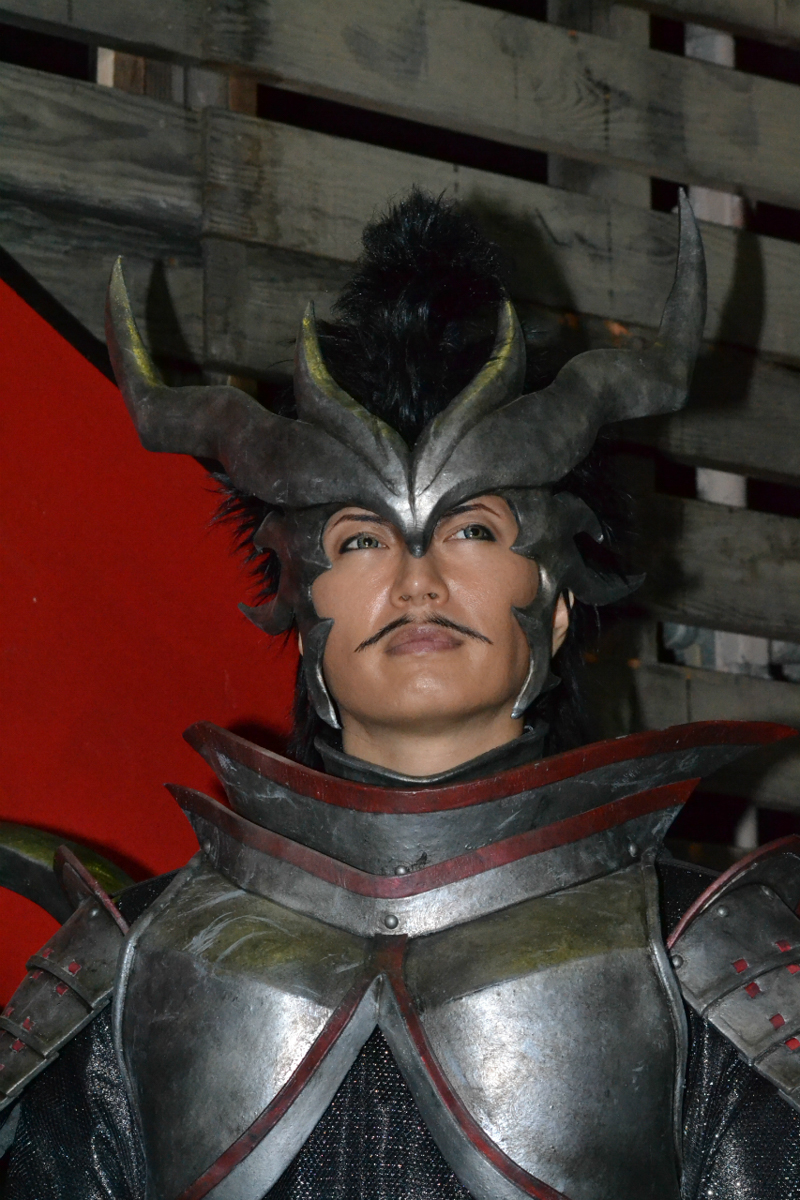
GACKT himself created the ending theme of the live action Sengoku Basara -Moonlight Party- with the song Hakuro, in which there are video images of him as Oda Nobunaga, here's a preview of the MV:
https://www.youtube.com/watch?v=-HmJ9urodNs
Japan Tradition: Hadaka Matsuri
The Hadaka Matsuri
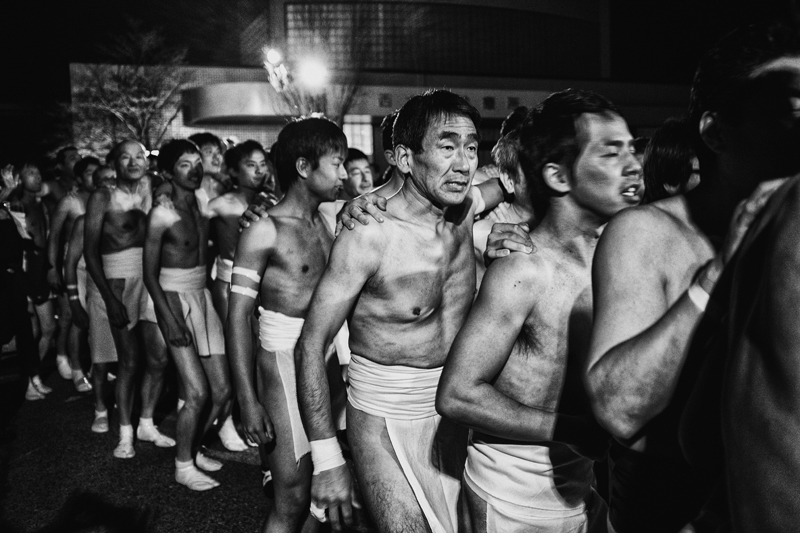
Even though nowadays nudity is not a shame anymore, in this part of the world, and not only here, it still is one of those topics usually considered tingly.
Nudity intrigues us, sometimes it upsets us, and it surely arouses our curiosity.
The Land of the rising sun is a place rich of costumes and traditions often in contrast with each other. Let's consider for example their obsession with good manners or the extreme attention to their privacy. But also their strong sense of decency and the districts dedicated to night pleasures and endless fun.
What better chance to 'bare ourselves', if not during the Hadaka Matsuri.
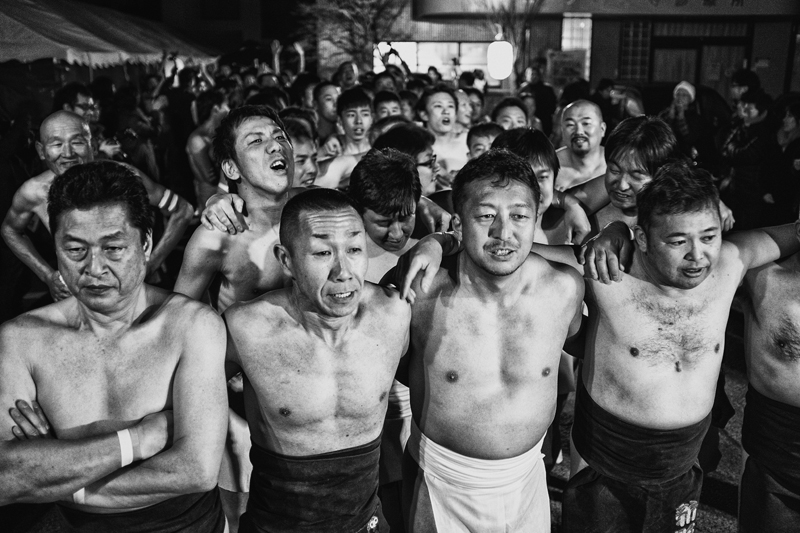
Before we focus on this particular celebration I would like to take a step back. In Japanese language the word matsuri indicates a traditional festival. These festivals usually coincide with an event that attracts thousands of people in streets and parks.
The Origin
A great number of festivals took their origin in Chinese traditional festivals. However these festivity tended to disappear as time passed by, mixing with, or even being replaced by typical Japanese costumes. In fact, in Japan, the idea of festival or celebration derives from the deep bond that this community has with nature. This bond can be traced in the traditional religion of the country, the Shintoism.
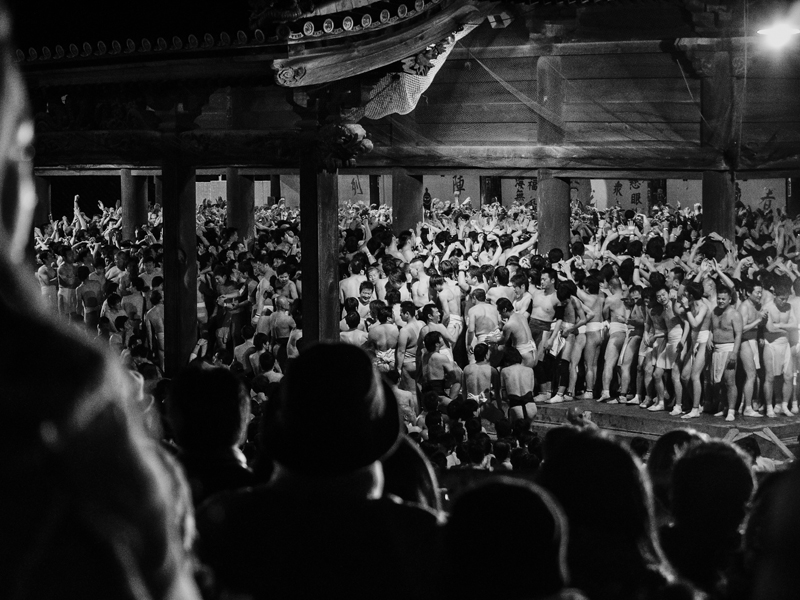
'Hadaka Matsuri' literally means 'Festival of the naked man'. During this celebration the approximately 9.000 participants, all men, wear nothing but the traditional Japanese loincloth, the fundoshi. for those who want to, they can wear a kimono too. But among all participants there are also men that decide to wear nothing at all.
This festival takes place in many different parts of Japan. The most important is the one that takes place in Okayama (city where this festival originated from), on the island of Honshu. It takes place in the Saidai-ji shrine, and in fact the full name of this festival would be "Saidaiji Eyo Hadaka Matsuri". As it a religious celebration it is absolutely forbidden to bring or drink alcohol. Also, men with tattoos can take part in it, but only if they cover them with a band.
The Hadaka Matsuri has ancient origins. It is said that it can traced back in 767 d.C, when worshipers competed to receive protection charms made of paper, the go-o, thrown to them by a priests.
Hadaka Matsuri and Nudity
According to some evidences, it is believed that those who were able to obtain one of these protection charms would be blessed with good fortune for one year.
Moreover, the collective belief saw in nudity something able to absorb evil forces and misfortune. In fact, the ones that caught the charm were also proclaimed 'Naked man' or 'Naked Spirit' (shin-otoko). All those that wished to get rid of their misfortune tried to touch him.
But still today it is not easy to 'touch' the fortunate man because of the many participants in this festival. Even for frequent participants it might take many years before they are able to touch him.
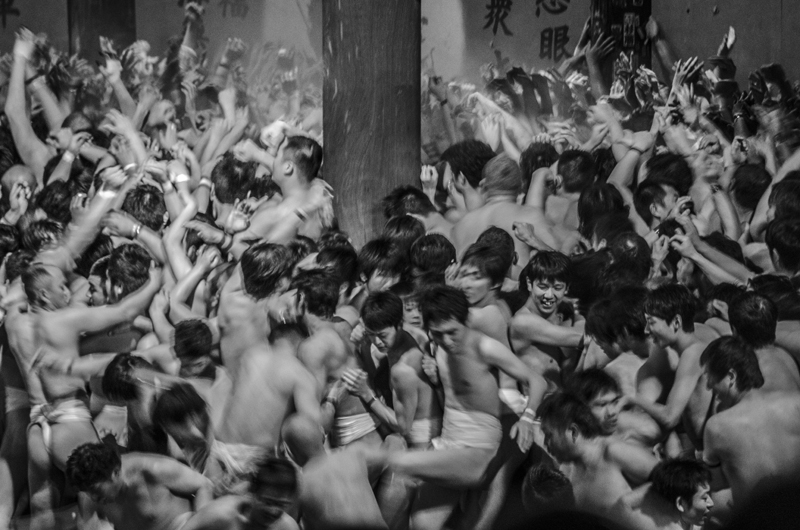
As time passed by, priests realized that the go-o made in paper did not last for long. In fact, they ended up being destroyed right because of the crowd that tried to catch them. Later, they were replaced by wooden sticks still used now and prepared by priests themselves through manual instruments.
And this is how nudity became a sacred tradition.
The Tradition
After a few days of isolation to keep vigil and pray, young participants move toward the shrine wearing only the fundoshi. They run while being hit by ice-cold jet of water. Reached the shrine, they have to catch one of the wooden sticks, the shingi. Priests throw these sticks to the crowd from the upper part of the Shrine. At 22:00, these charms are throw at them with almost all lights off to make it even more challenging. After catching the sticks, the first one that is able to put it in vertical position into a case filled with rice is proclaimed shin-otoko. The winner is blessed with one year of happiness and good fortune, and they will also receive a monetary prize.
Together with the shingi, priests throw 100 willow branches, and all those that are able to catch one will be granted with good fortune for the next year.
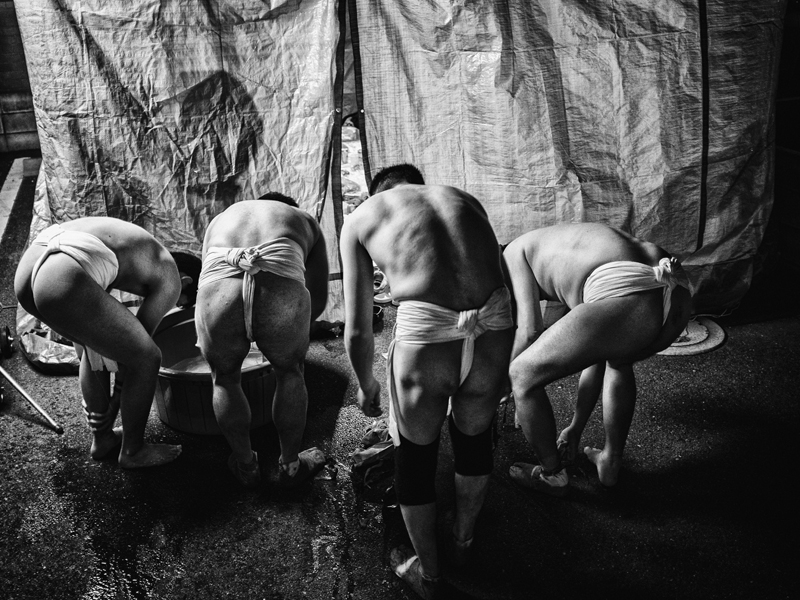
Less fortunate are the incidents that may happen due to the crowd. In the best case scenario they are 'only' bruises, broken noses or lips. For this reason that priests always ask participants to write down on their fundoshi (or on a piece of paper inside it) all useful information like: name, surname, address and blood type.
Fotografo : Kurt Gledhill
Japan Tradition: Seijin Shiki
Seijin Shiki
Seijin Shiki also known as Seijin no Hi (成人の日) is the Coming of Age day. This is a Japanese holiday held every year on the second Monday of January. The goal of this day is to congratulate and encourage all those who have become 20 years old, the age of maturity (二十歳 hatachi), in the past year.
In this day, many young Japanese celebrate with a Coming of Age ceremony, the Seijin-Shiki (成人式). The celebrations for this day are often held in local and prefectural offices. However, many people have after parties with family and friends right after. Also, it’s common to see many of these young peole walk in the street wearing traditional clothes.
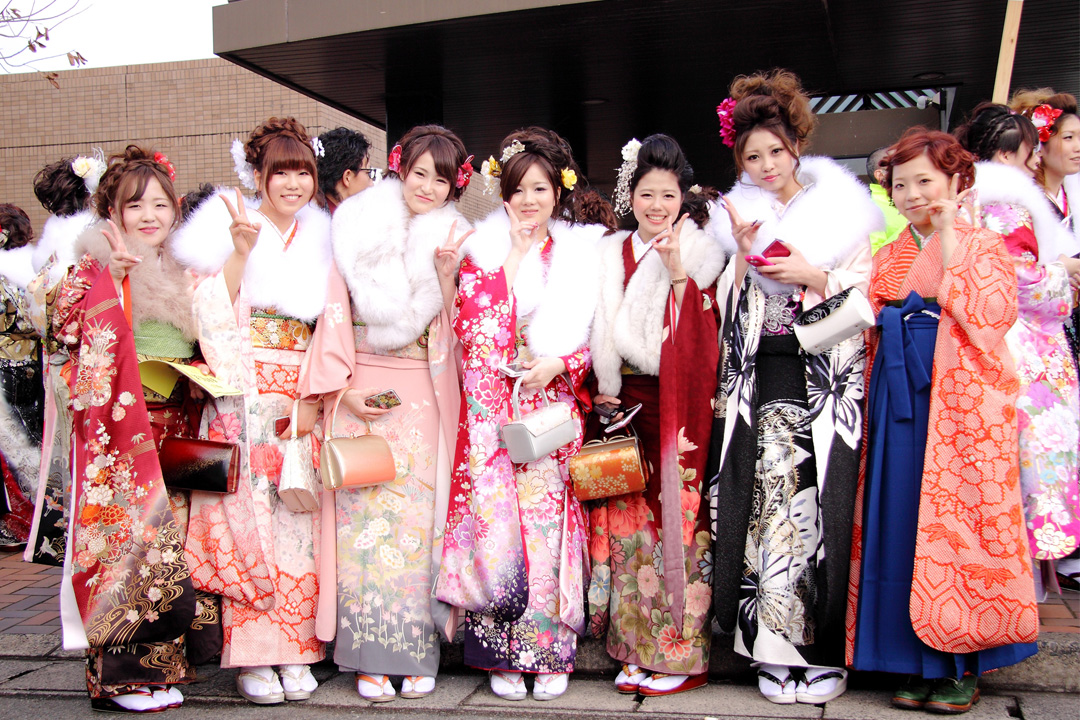
Shinjin Shiki, the Coming of Age ceremony, dates back to 714 in Japan. In this year, a young prince donned new robes and hairstyles to mark the passage into adulthood. However, the holiday was first established in 1948 and it was set to be celebrated every January 15th. Later in 2000, the date for Seijin Shiki changed and set to be celebrate in the second Monday of January.
Only those who celebrated their 20th birthday before the last Coming of age day or on the present one can join the celebrations.
Seijin Shiki celebrations
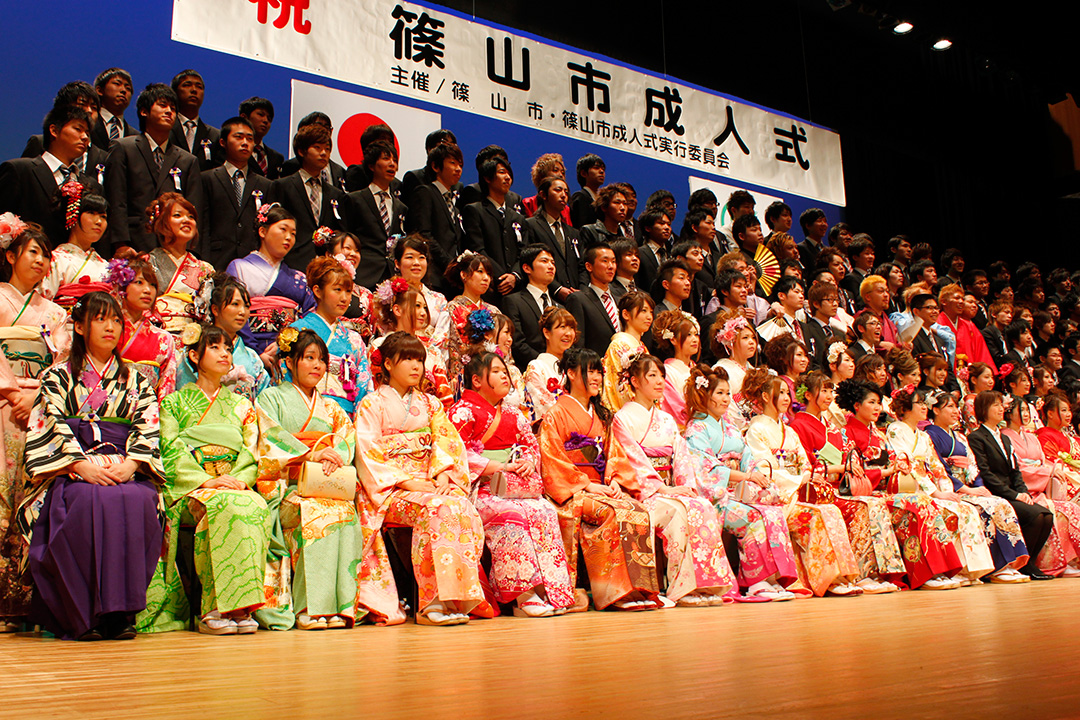
Sijin Shiki mark the age of maturity, which includes the expanded rights but also the increase of expected responsibilities. Usually, government officials give speeches and friends and family hand out small presents to the newly adults.
Women usually celebrate this day wearing furisode and zōri sandals that they can buy, borrow from a relative or rent for the occasion. Also men wear a traditional dress, like a dark kimono with hakama, but nowadays it’s not uncommon to see men wear a suit and tie.
After the formal ceremony, they often go out in groups to parties or drinking with friends.
Photo credit: Google images
Japanese Traditions: Ōmisoka - New year's traditions
Japanese Traditions: Ōmisoka - New year
Shogatsu (or Oshogatsu) is the new year for the land of the Rising Sun.
In the Meiji period, this date was coinciding with the Chinese lunar calendar, but during the restoration of the same period, Japan changed to the Gregorian calendar too, fixing January 1st as the festive day we all know.
For the westerners it’s almost impossible to think to gather 365 days in just one moment. However, opening your eyes in front of the sight of the Hatsuhinode (the dawn of the first sun of the year) it is considered good luck and as the representation of the year that’s about to begin. However, every year, celebrations start on December 28th when all the preparations for new year begin. During the days of the Shougatsu Sanganichi, only the primary services are available, while Japanese people dedicate themselves to the Susuharai, cleaning of the whole house to get rid of all the negative traces of the past year. Kadomatsu (pine braches) and Shimenawa (straw rope with stripes of colored paper) are hanged on the doorsteps to keep the bad spirits away.
Japanese postal office are actively sending out and delivering cards for the best wishes that need to reach friends and families before new year’s day, the nengajou (年賀状).
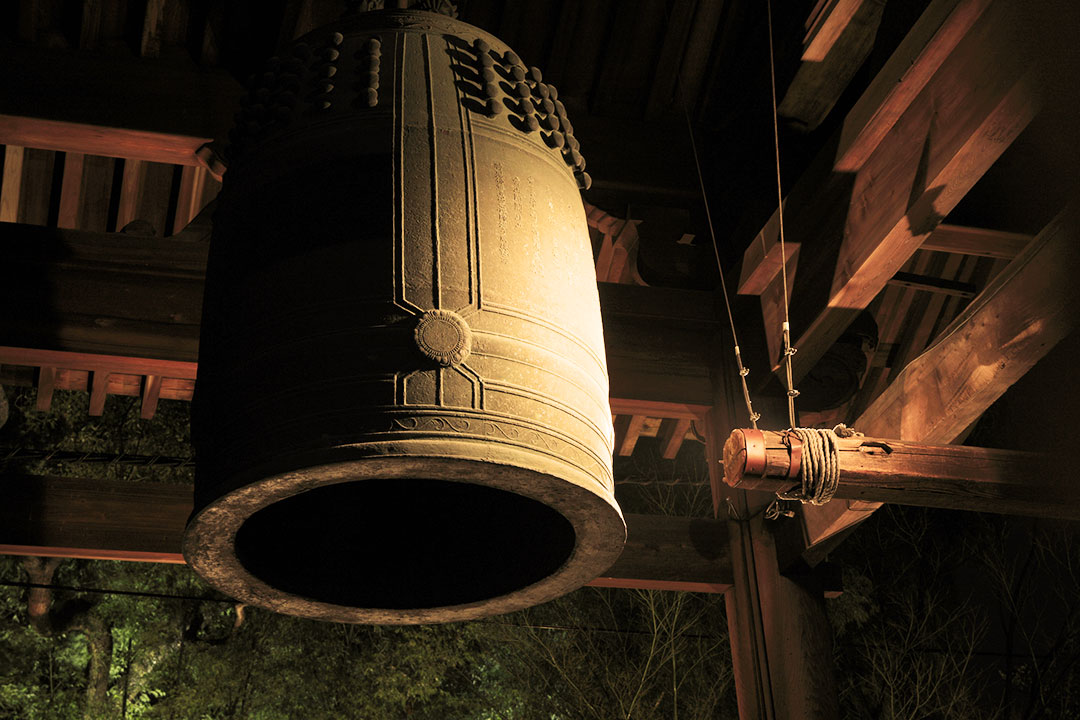
Everything is ready to spend the time with the family and on December 31st, that's when the Ōmisoka begins (literally New year’s eve, the last day of the year).
Around 10:30pm the Joya no Kane, the tolls from the Tsurigane (bell of the temple), begins. They are very slow, because the first toll has to stop ringing before a second one is taken. They go on until midnight for a total of 108 tolls. They are said to be purifying for all those who listen so that it’s possible to face a new chapter of our lives.
Traditional foods
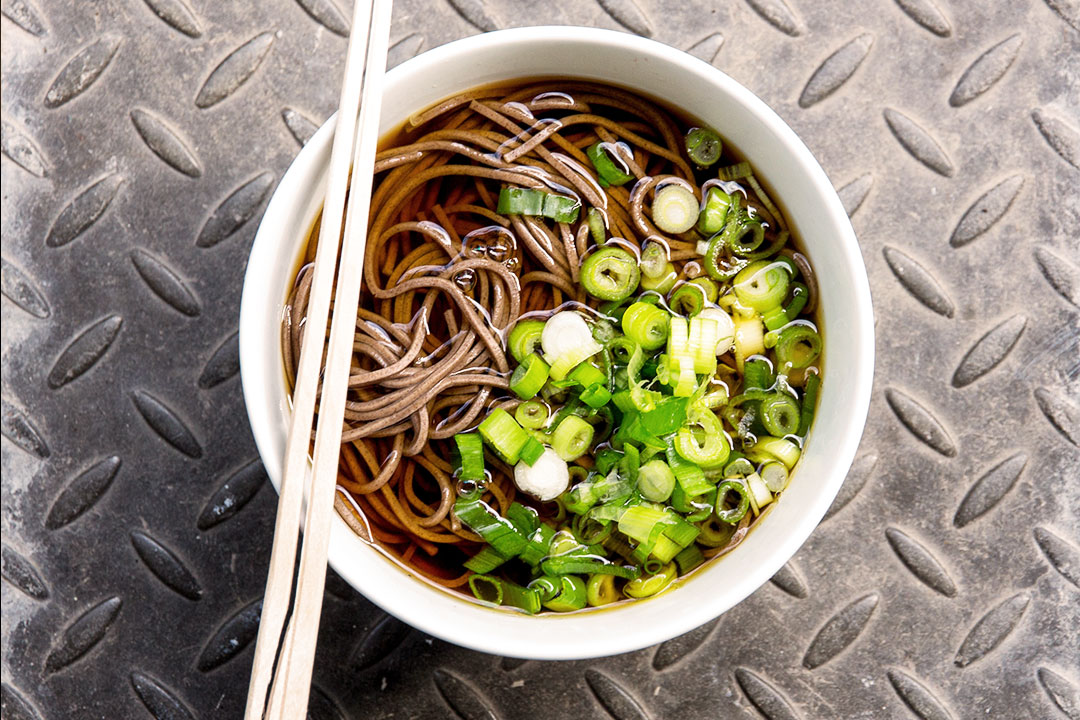
In this night it’s tradition to eat toshikoshi soba (年越しそば), noodles made with buckwheat, eggs and hot broth. The length of the noodles are auspice of a long life, their digestibility indicates the interior cleanliness and the ease in cutting them are a symbol of the removal of all bad things of the past.
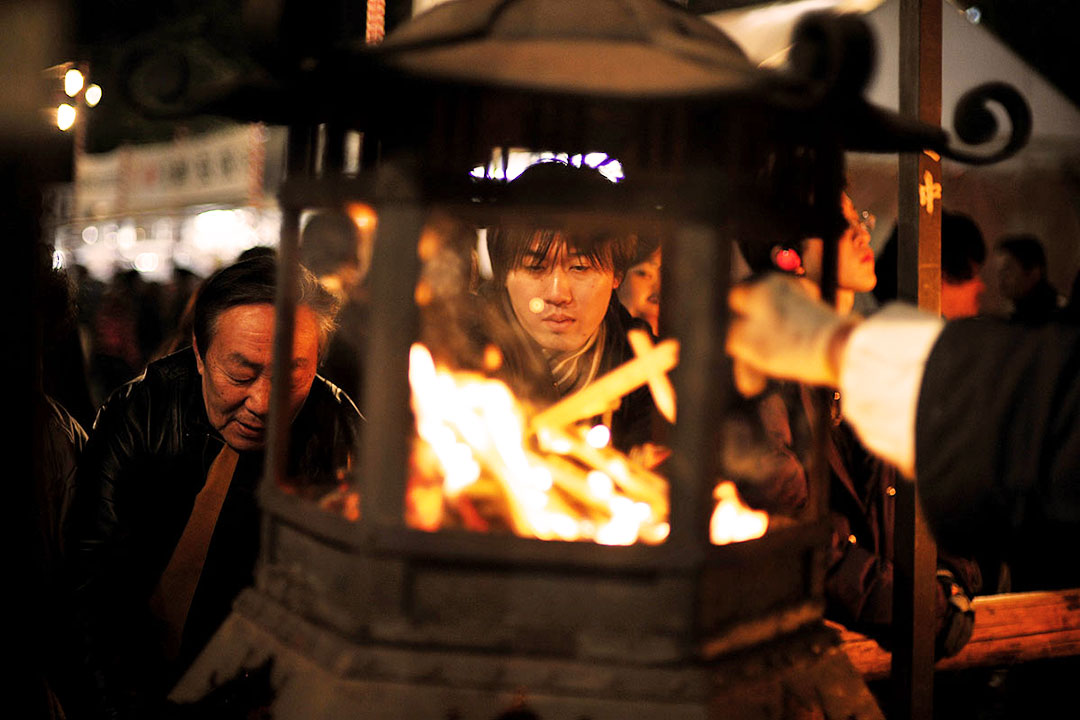
The day after, the first visit to the temple takes place, the HATSUMOUDE (初詣). To pray for health for every family member and their happiness is the right spirit to face a new beginning. Furthermore, Japanese kids usually receive a small engraved envelope, bukuro (袋), containing some money (otoshidama, お年玉).
Family and festivities are connected together also thanks to the food. On the tables you can find theosechi-ryouri (お節料理), specialties coming from the tradition like the kombu (昆布) weed. The kamaboko (蒲鉾, fish cake), kurikinton (栗きんとん, mash potatoes with chestunts), kinpiragobo (金平牛蒡, burdock boiled roots). The most loved and well known Kuro-mame (黒豆, sweet black soy beans) and of course sushi and sashimi. Due to all these specialties, on the 7th day of January there’s the jinjitsu (人日), the day for “stomach rest”, when you only eat the the nanakusa-gayu (七草粥, the soup of the seven herbs made with rice).
If you ever had the chance to be in Japan during the Ōmisoka, tell us in the comments or on our facebook page! We'd love to hear your thoughts and experiences.
Image source: Google








